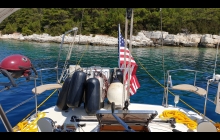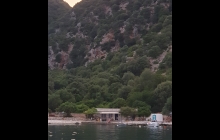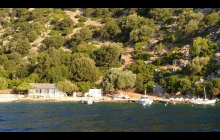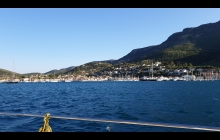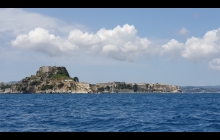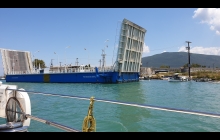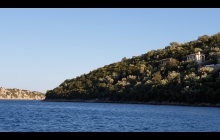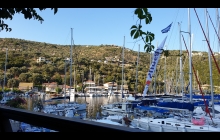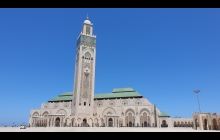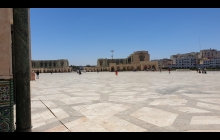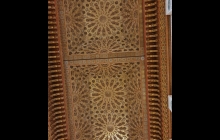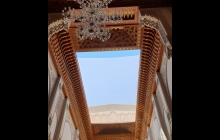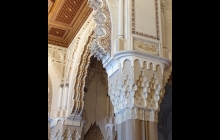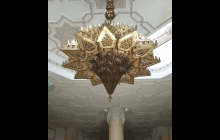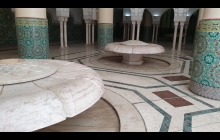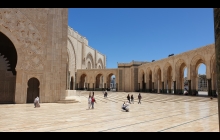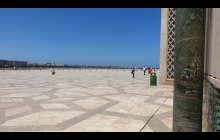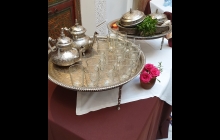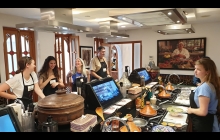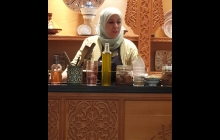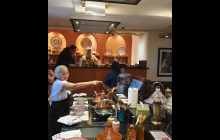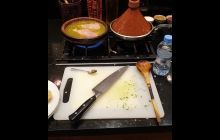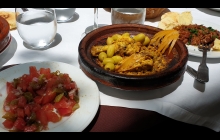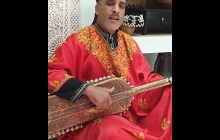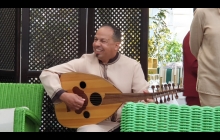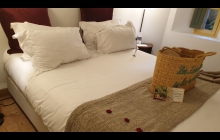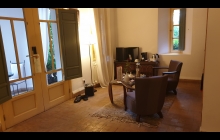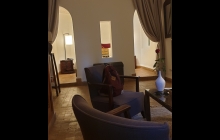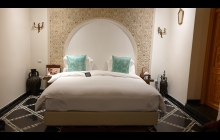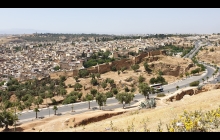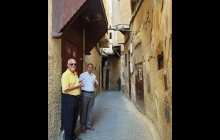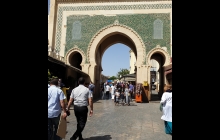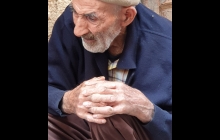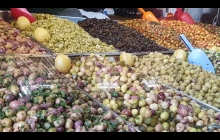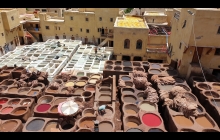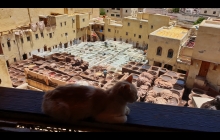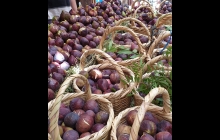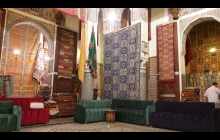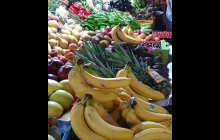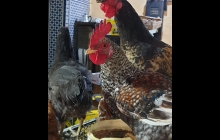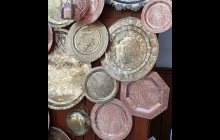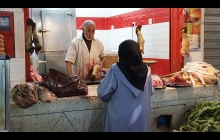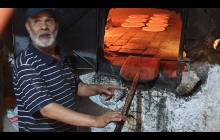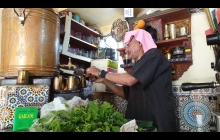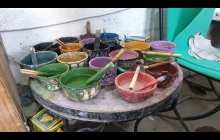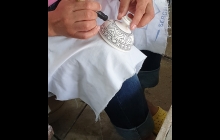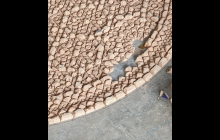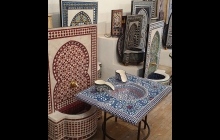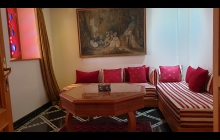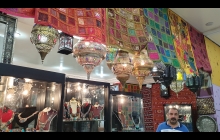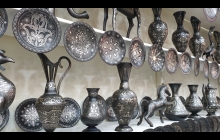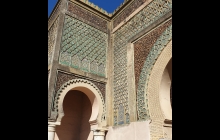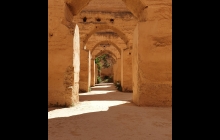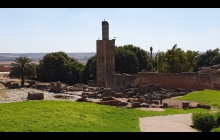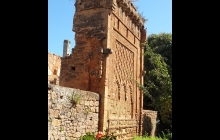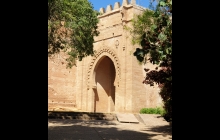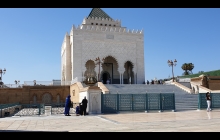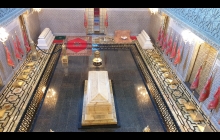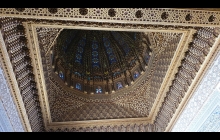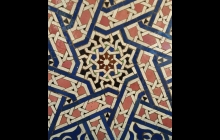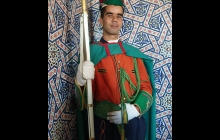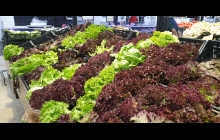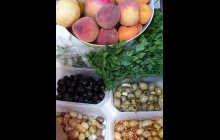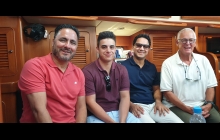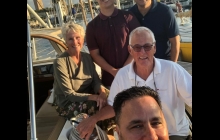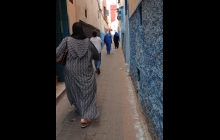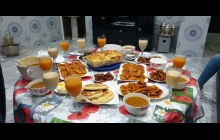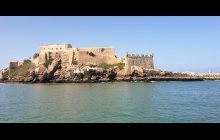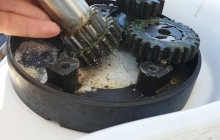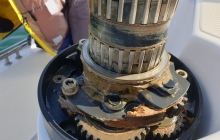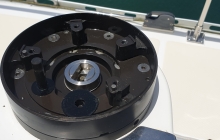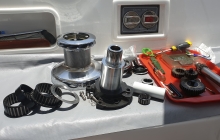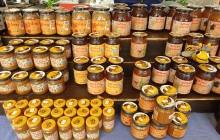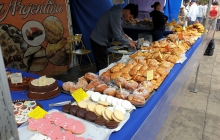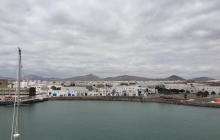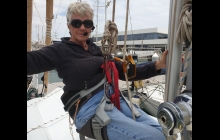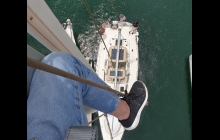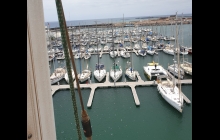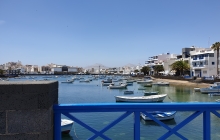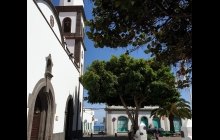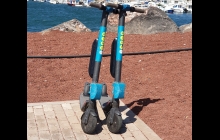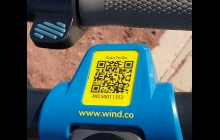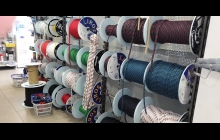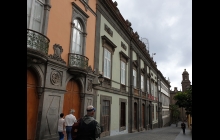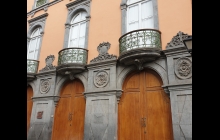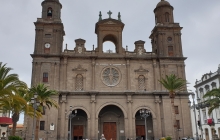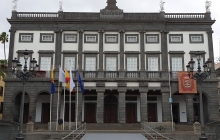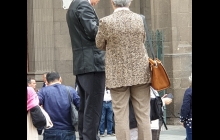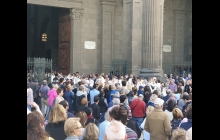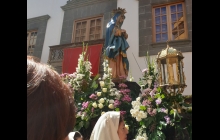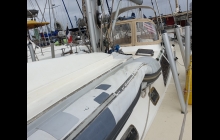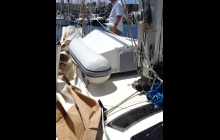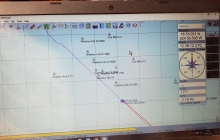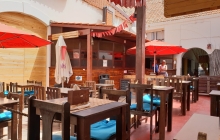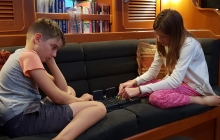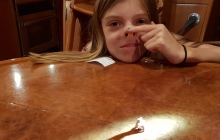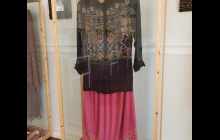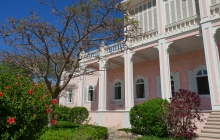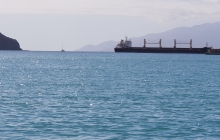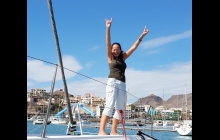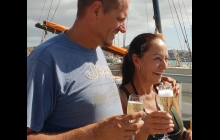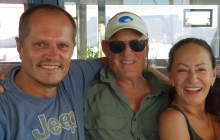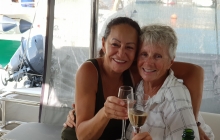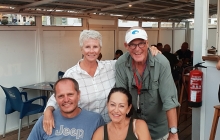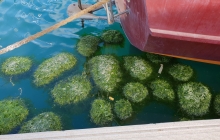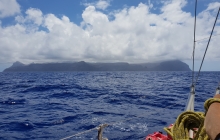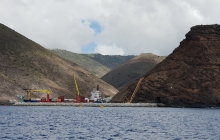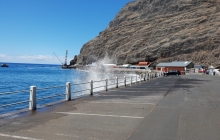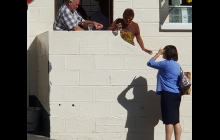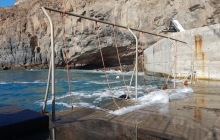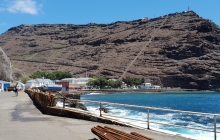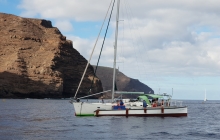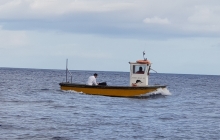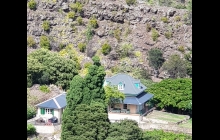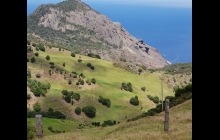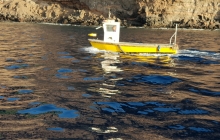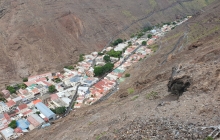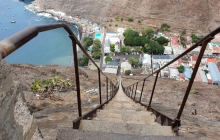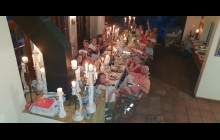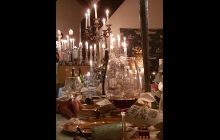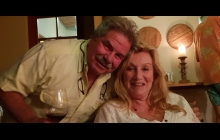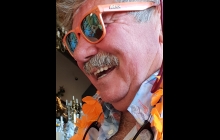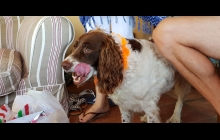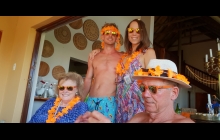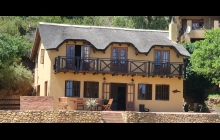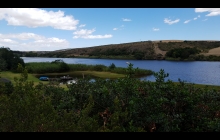Mersoleil
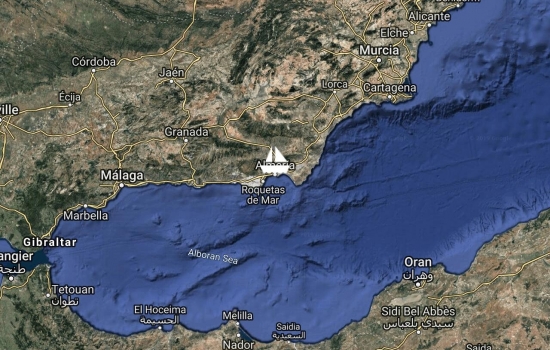
Have you noticed?
It's time for me to admit that things are moving so quickly I never seem to find time to post updates to YIT anymore. I haven't finished telling about Greece and have not even mentioned Turkey and how much we enjoyed being there!
In another week we're off on yet another long passage, our longest ever,
Now it's YOUR TURN!
Please write to us at sailingmersoleil@gmail.com and tell us what's going on in YOUR world. We promise to reply individually to your messages and we look forward to keeping in touch with you!
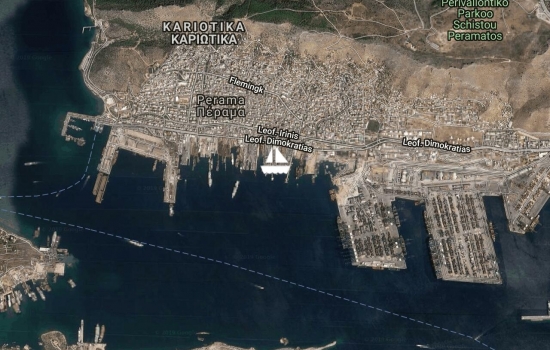
Greece... different from anyplace we have ever been. I've probably said this before, more than once, but it's true. The diversity in the world is marvelous.
We've already discussed the plethora of chartered sailboats touring the Greek islands under the guidance of ill-equipped and under-informed skippers. They've added an element of danger for us, from boats out of control in close spaces, and served as well or better as a source of amusement at cocktail time while we sit, snug in our cockpit having employed the Mersoleil rule of being at anchor not later than 3PM, watching other sailors plough into the anchorage only seconds before dark and well after the wind has risen enough to add to the challenge of anchoring for the night.
Before flying to Greece last month Mario Lewis read our stories about anchoring nightmares. While he was with us in the Ionian Sea islands, he had ample opportunity to see for himself how we can be amused, entertained and scared witless by the inept operation of nearby yachts. One night Mario even took a shift on anchor watch, ready to call all hands on deck, keeping an especially close eye on two or three suspicious vessels whose captains tried repeatedly to anchor just upwind of Mersoleil, then dragged back toward and past us, having failed to set their hooks. Later that night Robbie and I alternated watching in two-hour shifts until 2:30AM when the winds dropped a little and it appeared that the erratic movement of boats in Vathy Bay finally came to a halt.
We have never understood why any sailor would, instead of completely furling his foresail in a tidy roll, leave a small triangle of sail dangling prettily off the forestay with the sheets running back from the clew toward the cockpit. Most of the yachtsmen who sail in Greece seem to be partial to furling this way, leaving that triangle of sailcloth susceptible to dirt, UV damage and wear from the wind. Mario was the first to notice one evening the sad result of this practice. "What's going on over there? See that yellow boat with its sail flapping?" The three of us watched together (Robbie'd have gone to help, has done so in the past, but there were more than twenty five yachts closer than we were) as that poor little sail worried its lines loose and flapped itself to shreds in the stiff breeze. It was an expensive sail, too, one face shiny mylar. During the two or three breezy evenings that we sat at anchor in Vathy Bay, it being too breezy to sail elsewhere - better to just stay put, we saw another sail lost in the same way. $10,000 worth of sails wasted in the course of only two days. In eight years cruising, we've seen this happen only one other time, that on an unattended docked catamaran in a violent storm near Syndey. In that case, the violent crashing of the sail against itself and the rig awakened us in the middle of the night. Robbie and a couple of others ran to the boat, but by the time they reached it the furling line had jammed itself irretrievably in overrides around the furling drum and nothing could be done in time to save the sail.
Mario became remarkably adept at recognizing the problem boats as they entered the bay too fast, or too close, or with too many sunbathers and too few crew on deck, and his "oh boy, here comes one" quickly became a call to be taken seriously as the day drew to a close.
Mario's visit was such fun for us! He's a great sport, game for any adventure, generous with interesting stories and full of excellent questions about cruising. We enjoyed our time together, catching up on Robbie and Mario's years together in Texas, trying to understand what in general is going on in America, testing Greek beers, trying as many restaurants as we could and lazing together in the sunshine. The weather was really hot in August and little hiking or exploring took place, but we spent an entire week of quality time together and had one fantastic morning under sail in the Ionian Sea. It was a delight to have him aboard Mersoleil.
Robbie made another attempt, on the penultimate day of Mario's stay, to lay chain loops over the rocks on shore and to run long lines from our stern to the rocks. He motored away in The Puppy, draped one chain over the first spot he selected, then began to move to the left searching for a perfect location for the second chain. As I motored Mersoleil back and forth a short distance offshore, Mario and I watched carefully so we'd know the exact locations of the chains and would be able to back directly toward the chosen location. Then... did we miss something?
"Did you see him place the second chain?" I asked Mario.
"No! I saw him put one. I don't think he ever put the other one out!"
"He's coming back! If he put a chain around a rock...." I mused aloud.
Mario finished for me, "If he did, it's way too close to the first one! But I never saw him do it. He's coming back! What is he doing?"
Robbie was motoring furiously toward Mersoleil waving his arms and yelling, though we couldn't hear him, "Come BACK! Don't go away!!" As he reached the stern side of Mersoleil he threw the Puppy's painter at me and yelled, "Quick, tie it off and get me up there! I was yelling... and you were moving away... and the rocks put a big hole in The Puppy... and he's sinking!"
True enough, The Puppy was still making farting sounds and taking on water in his starboard pontoon and Robbie's weight together with the 9.9hp outboard were in danger of sinking the dinghy, ruining the motor and sending His Robbiness for an unplanned swim! After moving away from that rocky shore out into good water we began to take amelioraitve measures. Since I weigh less than either of the boys, I climbed into the gradually sinking dinghy and released the outboard motor. Robbie hauled it up onto the rail using our usual block and tackle hoist, then I scrambled out of the sinking tender. We raised The Puppy up on deck to prevent the intake of more water, tied him down and had a good laugh. And moved to a different spot to anchor for the night. Once more I say, Phooey on that stern-tie business. Now we are fully cured and we have achieved yet another first, first time ever we've had a rip-roaring hole in our tender.
Add 'small crisis' to the list of typical cruising experiences arranged for Mario Lewis' enjoyment on his adventure to the Greek Ionian islands! Mario's last 48 hours in Greece included several transfers by water taxi to and from the charming town of Eufimia, Kefalonia, for ice cream, tavernas and finally, a taxi ride to the Anna Pollatou Airport near Argostoli. Thanks for coming, Mario!
It had been our plan then to sail another twenty miles south to the southernmost Ionian Island of Zakynthos where friends Nicholas and Dimitra (whom we met in 2018 in India) own a seaside property with holiday villas. www.lithalona.com The bay on which their estate is located is heavily protected, as a nesting place of the loggerhead sea turtle, but anchoring is permitted just in front of the Lithalona property and we've been looking forward to a nice visit on Zakynthos. Alas, with a disabled dinghy, we had no way to get to shore to see our friends who live on the island through the summer season and in Athens from October till June. We sent our apologies to Dimitra and Nicholas and turned instead toward Athens where we'd planned to go a week later for antifoul (every 2 years) and a few other small projects.
I was surprised at the scenic beauty as we motored in calm air through the Gulf of Patras toward Athens. What did I expect? Maybe I've seen one too many pictures of Mikonos, but the unexpected steep dry mountains of central Greece reminded me of New Zealand's Hauraki Gulf at the end of the summer. Dry, rocky, mostly brown slopes rising from the sea. Only the hardiest plants still hold onto their green by late August. It was beautiful and amazingly unmarred by signs of population. 3 million people, about a third of Greece's entire population, live in the Athens metropolitan area and despite the country's 3,400 years of recorded history it's not bursting at the seams with people who have nowhere to live, but continues to support a vibrant rural population with small villages existing much the way they have for millennia.
More surprises as we continued into the Gulf of Corinth and on toward Athens. At a narrow point between the Gulf of Patras and the Gulf of Corinth we passed under the stunning Rion-Antirion Bridge, of which I had never heard, but quite a wonder of the world! Completed in 2004, it's the longest cable-span bridge in the world at about 3km and straddles the seismically active expanding Corinth Gulf Rift zone. That's not all, it's beautiful, lighted at night and one of those things that makes me think to myself, "this has been here since 2004 and I didn't even know about it!?" Look at the pictures! Rion Bridge Traffic Control calls all the shots here by VHF radio and Mersoleil was granted permission to transit the bridge, "just keep on coming and pass through the North span, one pillar to the left and three to the right." The morning sun gave me some nice shots of the bridge looking back at it after we passed underneath.
Further on, at Corinth, we transited the Corinth Canal, yet another first for Mersoleil and even more exciting than the bridge. Ancient Greek history is full of tales as early as the 7th century BC of ships being hauled overland across the narrow isthmus at Corinth in order to reach or surprise the enemy, whether Turks on the east or Italians on the west. Digging a canal was discussed for centuries, begun by Roman emporers who were ultimately either discouraged by costs or distracted by goings on in Gaul, but never completed. The canal was finally completed by a French engineering firm late in the 19th century entirely at sea level - no locks. At its narrowest point only 25m wide, the Corinth Canal carries almost no commercial traffic but is of great interest to tourists and an outstanding shortcut for the yachtsman wishing to get from Ionian to Aegean Sea without going the long way around the Peloponese.
Vessels congregate outside the canal until Corinth Canal Traffic Control announces the reversal of traffic and calls vessels one by one to enter the canal, telling any who dawdle in the narrow confines to "move at top speed." The wait for one's turn to pass through can be as long as three hours and unless arrangements have been made with an agent there is a mandatory stop at the control tower to pay the hefty canal fee. EUR 275 for our 14m yacht to travel about 3.5nm. Expensive, but it was thrilling and it saved us days en route to Athens.
I have time to tell you about all this now because we are delayed in departing Halkitis Shipyards to resolve some battery issues that cropped up the first time we fired up the new bow thruster. Always somethin.
NOTE TO YACHTIES: Halkitis Shipyard-Athens. Best shipyard experience we have ever had, bar none, and we've been in some excellent shipyards! Mr. Lekkas (Elefterios Lekkas) will take excellent care of you, arranging the best trades in the Athens area to perform any work not available from Halkitis. The workmanship is superior and the prices, even with Greece's dreaded 24% VAT, are not higher than we have paid elsewhere. +30 210 402 0256 www.halkitis-shipyards.gr 37 57.61N 23 34.39.84E We were allowed to stay onboard during the work and a weekend in a suburban Athens shipyard afforded ample opportunity to hop a cab into the city to visit the Acropolis!
It's late Friday afternoon now and I suspect we'll be here till Monday afternoon. That will give me time to upload photos and to tell you about visiting the Parthenon! I didn't know it was on my bucket list, but WOW! What an experience.
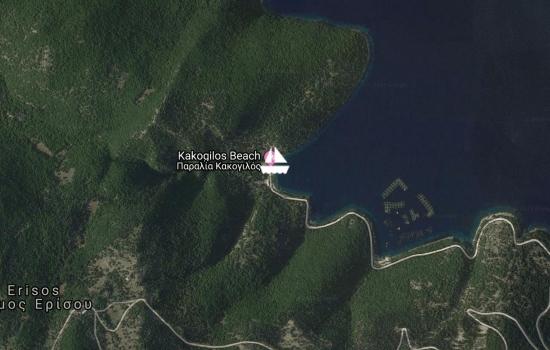
In FIskardho on Tuesday morning, the day after tomorrow, we'll meet Mario Lewis, our guest for the next week or so. In order to be there and settled before he arrives, we motored from Vathi, Ithaka, back over to Kefalonia on Friday morning to scope out Fiskardho.
We found very little room to anchor at Fiskardho, lots of vessels already there by noon, nearly all of them tied stern-to the rocky shore. After four attempts to anchor in about 85' (27m) of water with the anchor pulling loose each time we backed down on it, we decided to overnight elsewhere and have another go at Fiskardho on the next day.
There are a number of small sheltered indentations along the east side of Kephalonia, but we found them all occupied as we shopped our way south in the Ithaka Channel until we reached a small cove four miles away from Fiskardho, Kakongylos Cove. A fish farm operation , the first one we've seen in Greece, dominates the SE portion of the cove and there are two little rocky beaches at the head of the cove separated by a small protruding point. High mountains shelter the cove on N, W and S.
Black goats, white goats and a few tan ones bleat in the afternoon as they browse shrubs on the steep rocky mountainside, and a family lives in a small house right on the water in the second cove, their wooden fishing boats bobbing in the water just front of the house. An idyllic spot, really, one where for the first time in a year or more we felt alone in a quiet tranquil place.
Yesterday morning we returned to Fiskardho determined to experiment with the dreaded technique of going stern-to the rocks. It's a lengthy process, and after we dropped the anchor several boat lengths away from the rocks, Robbie went ashore in the dinghy and draped two loops of chain over his selected rocks while I backed Mersoleil into position perilously close to shore. He returned to the boat to receive the end of a 22mm yellow floating line and then to drag it to the first of the chain loops, hitching it onto the chain with a bowline. A kind Italian guy on the neighboring boat helped, making the knot on one line, while Robbie tied the other. I left Mersoleil straining on her anchor rode in reverse idle while I paid out the huge yellow ropes to Luca on one side and Robbie on the other, then snugged them up on deck to the best of my ability (a joke at best) and cleated them off. Once that was complete, I returned to the bow, snugged up the anchor rode, effectively moving Mersoleil a little further offshore (but not enough, will do better next time) and firming up all the attachment points - 2 yellow lines and a chain.
We sat this way at 2PM when the afternoon NW breeze began to kick up, pushing Mersoleil hard to port and Robbie went ashore without me to pay homage to the Port Polis and to reconnoiter a suitable spot for Tuesday's rendezvous with Mario. I stayed onboard, essentially on anchor watch, ready to drop those yellow lines and motor off the rocky shoreline if I didn't like the conditions.
I did not like the conditions. I had no idea how well set the anchor was and now I wished I'd dropped the hook further from shore. I'd shortened the rode when I pulled Mersoleil forward to a length I would never swing on. There was tremendous strain on the windward stern line and I began to question the rated load of the stainless steel clips I had used to turn 3m of chain into a single loop.
As soon as Robbie returned from town, I dropped the stern lines, raised anchor, and motored off, waiting out in open water while he gathered into the dinghy the chains and floating rope.
....And we returned to our bucolic cove with the bleating goats and the family of fishermen for another night of blissful silence. Breezes that evening topped 20kts and we were very happy not to be stern-to at Fiskardho.
Last night, Saturday night, our hearts were warmed by a family gathering at the house on the beach. The son, wife and three or four kids came to spend the evening, sitting on the porch at waters' edge with mom and pop, laughing and chatting till dark the way I remember my family doing on Sunday evenings at Grandma and Grandpa Clewell's house in Eagle Point Park overlooking the Mississippi River. Somebody gathered a small collection of stuff, rubbish I imagine, and set it alight floating on the water. As it slowly drifted away from the steps the kids picked up small rocks from the beach and pelted the fire with them, or tried to. A couple of well placed shots added by dad, unable to resist a good rock-throwing opportunity, dowsed and sunk the fire as it floated away, amid laughter and general approbation of all the family. True to form in any such family get-together, around 9 o'clock children started crying, darkness fell, headlights went on and one vehicle drove away. Then all was blissfully quiet.
I did the math last night on that stern-to technique, now that I understood it a little better and could identify a few of our mistakes. Other people probably don't do it this way (well, the Germans do, I'll wager) but there's some simple math involved. The length of one's anchor rode plus boat length plus length of shore lines plus an estimate of how far the anchor will drag on the bottom before hooking minus the lengths required for knotting and cleating the floating lines give the exact distance from shore at which the anchor should be dropped. For Mersoleil that's about 120m. After that, everything is a simple matter of adjustment, lengthening line(s) at one end while snugging up at the other and ending with the boat not too close to shore and not too close to the anchor.
None of that matters when the wind rises to 18kts and it's on the beam, pushing your vessel into the one next door or his onto yours, and I just wanted to be out of there! After analyzing the math, I know we can do this better the next time. And it is my great hope that there will not be a next time.
We will make a drive-by pickup when Mario arrives. Robbie will take The Puppy ashore, discard a bag of trash, check out of Fiskardho with the Port Polis, stop at the grocer, and collect our friend while I drift or drive Mersoleil around in circles in a nice safe place.
I'll say it again. Phooey on that stern-to business.

We had another conversation about guns this morning over coffee and agree that America needs to simply outlaw the private ownership of guns, period. I still have concerns, having grown up in the midwest, for the family that hunts in the fall, freezes their annual supply of meat and would not be able to eat so well without it, and also for the farmer or rancher who protects his livestock by culling predators. It does seem that those people have a legitimate reason to own guns.
My latest thought is that private gun ownership might be permissible on a very tiny scale with permission extended ONLY to specific individuals who can demonstrate a viable reason, like those above, to possess a weapon. I'm suggesting an honest-to-God personal interview before a tribunal who would personally issue or deny the permit after thorough investigation. And if we can't get that right, then no guns at all.
All that said, I believe it will simply never happen in the United States of America, where the essence of the country's existence is defined by the people's insistence upon rugged individualism, the "I want to do what I want to do, dammit" way of life. Those on the other side of a political question, any "other side," don't even see that they are in fact insisting upon the very same thing, thinking "I want this entire country to have what I believe is best and it's my right to insist upon that." In our culture, with its inherent egoistic predispositions, consensus will never happen. No one will give up his personal beliefs, opinions, positions. And Americans will continue to die and America, and Americans as individuals, will continue to slide to the depths of disrespect in the opinion of the rest of the world.
What will it take? Love. Nothing else. Not laws. Not protests, Not demonstrations, or referenda, or more senseless tragedy. I observe sadly that altruistic love is far far from the American way of the last century. It's pathetic, and we are sorry to confess that we cannot imagine going back to America to live. The condition of my country brings tears to my eyes.
The day of my last YIT post, the day when I said more wind was predicted for that night... A 2017 57' Oyster pulled in front of us and dropped the hook. We know the couple, professional crew, and were thrilled that they were fending our bow. They're not going to drag and wreck a new Oyster, one of the most expensive semi-custom yachts built.
When it began to get crazy, as the breezes topped 22, boats were returning from their day at sea and trying to anchor, fearing they wouldn't be able to Med moor, but not knowing how to set their anchors either. Most of these boats carry only underweight Bruce or CQR-type ground tackle. So they have insufficient equipment, no skill and there was much yelling and excitement. As one boat dragged backwards past us the guy yelled, "Can we tie to you?" to which we both bellowed a resounding NOOO!
At one point at least six boats were dragging all at the same time, spinning in fast circles (they all drive too fast, think they are in Jeep Cherokees) and trying to maneuver in tight spaces without control. A pair of boats, dangerously close to our stbd side, got their chains crossed and went spinning in the wind past us like a big pinwheel. That inspired Kerr, on the Oyster, to haul his dink up on the davits and start raising his anchor to leave. Without him in front of Mersoleil we certainly weren't going to stay, either, so we did the same.
It was chaos, and there was a lot of yelling. We followed Vida Mia, the Oyster, to a different location a few miles away and went over to their boat for sundowners, well-deserved by all.
Now at Vathy, Ithaka, a charming little town with a large bay and plenty of town quay for stern-to mooring. Still, before dark there are at least 50 yachts at anchor here, too, and the wind comes up as the sun goes down.
Last night's amusing twist was that a young couple in a dinghy were going from boat to boat offering to help people who didn't know how or couldn't decide where to anchor. The remarkable thing about them, we dubbed them The Busybodies, was that THEY didn't seem to know what they were doing either and they put a boat right between us and another anchored charter boat where there wasn't anywhere near enough space. Those two boats nearly bashed stern to stern in a big fat spin, after which The Busybodies slunk off to a different part of the anchorage where their reputations were still untarnished, and offered to help people over there!
This morning we moved 600' further out into deeper water and, conveniently, upwind in the prevailing NWerly. Now we're in 72' of water (22m) and we hope we've made room for everyone else closer to shore.
PHOTOS OF VATHY COMING... maybe tomorrow
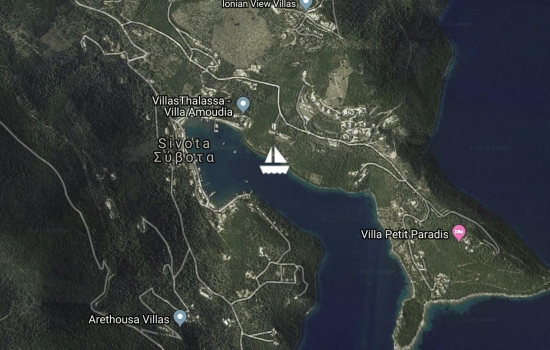
Greece is everything we hoped it would be and more, which comes as a delightful surprise after all the complaining we've heard about sailing in the Med, especially in Greece.
Conceded, charter boats operated by idiots are virtually everywhere, the anchorages in the Ionian are crowded every single night and chock-full early in the day, tourism drives the lives of the locals during the summer, it's nearly impossible to develop a meaningful relationship with any of the Greek people who live on these islands, marina prices are outrageous and one pays too much for a mediocre meal in a taverna, But there are other things to enjoy and they cannot be overstated!
First, Robbie and I have concluded that the Greecian Islands are indeed the premier cruising and sailing destination in the world, and for some very good reasons. Location. Scenic beauty. Phenomenal weather. Availability of excellent marine services. History. Culture. Variety. Easy access via international and domestic airports all over Greece. True, splendid isolation such as one can find in Fiji is non-existent. Everyone wants to be here. Who wouldn't? It would be mean to wish away all the tourists and charter yacht folks crowding these lovely islands and their surrounding waters. Who are we, tourists ourselves if truth be told, to demand that the most gorgeous crusing grounds in the world be left to us alone? Indeed everyone wants to be here. We might as well enjoy it and congratulate ourselves on our excellent taste. Along with everybody else.
The Ionian Islands, lying along the west coast of mainland Greece at the bottom of the Adriatic Sea, are green and lush, mountainous, and covered with olive and cypress trees. They're the home of the myths, the legends, much of Greek history and were long influenced by Italy just 50 miles away. Unfortunately a 1953 earthquake destroyed most of the Italianate architecture on these islands - lovely as they are today, how charming these Ionian villagess must have been a hungred years ago. Further south, once past the bulk of the Pelopenese Peninsula, lie the Cyclades, the Dodecanese and more, groups of dry rocky islands with the whitewashed bungalows and blue trim featured in travel brochures, where tourism is rampant and the possibility of losing one's patience with it increases. We'll be moving in that direction in a few weeks but for now, the charm of the wooded mountains embracing protected harbours where the sun rises late and there's a taverna ashore with dolmades and saganaki quite satisfies all our whims.
Complain about the flocks of lobsters if you will, the white-skinned tourists who've come from northern climes for a one-week stay and turn bright red upon exposure to the sun, their comic value as the day draws to a close and they prepare to moor or anchor their rented vessels is a treat not to be missed. The anchoring show is quite a spectator event! Neophytes ourselves once-upon-a-time, we have earned the right to chuckle.
Anchoring 101 for the land lubber: Motor slowly, directly into the wind, bringing the boat to a stop at the place where you'd like to drop the anchor. Lower anchor and chain as rapidly as possible by free-fall, or more sedately by electric push-button deployment, until there's more chain off the bow than the depth of the water (which depth you've carefully noted), substantially more if the water is deep. Then just allow the wind to drift the vessel back or motor slowly in reverse, paying out more chain as the boat moves, until there's at least 4 times as much chain deployed as that starting depth. More chain is even better, 7 times or even 10 times the depth, but in a crowded anchorage one rarely has the luxury of monolopizing a gigantic swing circle. That's it. Done.
More, the experienced sailor will note carefully that beginning depth, will back down under power on the chain and anchor testing their hold in the seabed, will add a rope snubber to the chain to take unnecessary strain off the windlass or anchor winch, will sit in the cockpit for half an hour or more (beer or wine optional) watching how and where the boat settles and its relation to other vessels already at anchor, will record the precise position of the anchor at the place where it set (guaranteed never to be the location where it was initially dropped, see also our thrilling YIT post of May 18 2018), and will move his boat and do it over again if he's not completely satisfied that he achieved the desired effect.
There are lots of further refinements, everybody's procedure slightly different. John Gans' philosophy of anchoring, for example, is, "Get as far as you can away from everybody and drop all the chain you've got!" And, for our part, we don't just back down perfunctorily on our anchor. We back down for a full 2 minutes at 2600rpm. If it holds under that kind of test, it's going to hold in a blow and we sleep well at night.,
Now, some highlights of the anchoring show just before sundown every day in the Greek isles. Some of the common sights we like to enjoy over a glass of wine or a gin & tonic are these.
1) Boat rips into the anchorage at about 6kts (that's too fast) and starts letting out chain without slowing down, then continues to drive forward running over his own chain, anchor lying on the bottom on its back, just following along. He stops the boat with anchor still lying upside down on the bottom, puts on a shirt, jumps in the dinghy and goes to nearest bar for sundowners;
2) Helmsman throws the boat into reverse while it's still moving forward at a fairly brisk clip, then drops the anchor which won't strike the seabed until he's 50m or more away from his chosen spot. He ends up far from his preferred location, can't imagine how that happened, but settles for what he got and hopes it's OK;
3) Vessel in scenario 2 keeps backing up until it's in deep water, deeper than the entire length of his anchor rode (usually all chain, sometimes a chain/rope combination), while the anchor just dangles suspended in the water at the bottom of the chain. In this case, it's typical for the boat to keep backing up, right out of the anchorage area, while two or three people stand at the bow looking down into the water at we know not what;
4) Helmsman wants to be sure his vessel does not end up right between two other boats that are already close together, so he proceeds between the boats to a position well ahead of them, then drops his anchor there, enabling his vessel to fall back eventually and rest precisely between the two boats in the spot he took pains to avoid;
5) Helmsman, usually the husband, instructs bow crew, usually the wife, to drop 15m of chain in 12m of water, then with no weight lying on the seabed and the anchor's pick skipping along the bottom on its toes, at such a steep angle it cannot possible dig in, he backs the boat out of the anchorage until he realizes something has gone wrong and she has made a mistake;
6) And, this is one of our favourites, with eight boats already at anchor, all facing west, all eight bows directly into the wind, a ninth vessel motors into and through the anchorage, turns 180 degrees to face east, drops the hook with the wind at his back, and motors backwards against the wind, thinking he has cleverly eluded all the other boats who've followed the same- but opposite - plan. Then satisfied that he's set his anchor, and is all alone facing the eight other vessels, he shuts off his engine and is dumbfounded to see his boat slowly turning in a circle and going in the opposite direction all by itself. What can he possibly be thinking? 'Everybody else is going that way, so I'll go this other way?'
Residents of Sivota, a tiny hamlet at the bottom end of the island of Levkas, depend for their livelihood upon the yachting community, specifically the charter yachting community, there being negligible numbers of owner-occupied yachts calling here. Right on the waterfront they have opened eight or ten tavernas, a few grocery stores all exaggerratedly named supermarkets, and just a few shops selling Greek food (picture such shops at airports enticing you to load up on gifts for those at home who will feel neglected if you fail to drag back some little memento of your holiday) and tourist junk. Levkas is connected to the Greek mainland by a swing bridge that opens on the hour, crossing the Levkas Channel more than an hour away by car from little Sivota, so these people are really isolated in their tiny beautiful corner of the world.
Employed at Sivota is an interesting twist on the standard marina business model. About six of the families who operate local tavernas have invested in pontoons, floating docks, where yachts can Med moor (tie stern-to the pontoon with a bow anchor dropped at a distance to hold the front end of the yacht). They don't charge for using the pontoons, but users are expected to dine at their host taverna.
Of the 125 yachts in Sivota every night in July and August, more than 100 of them moor stern-to at one of these pontoons or along the town quay. Boats chartered from Sail Ionian, or Sunsail, or Nielsen Sailing seem to make up the majority and their operators seem to have little or no experience at operating sailboats at all, let alone mooring in reverse with an anchor and two stern lines. They drop fenders in abundance to protect their fiberglass sides and then... well, that's when the excitement begins. Some just bash their 5m wide boats into a 4m wide gap, hoping the two vessels on either side can be pushed aside a little further. Most manage to fit into the targeted open spot, but they dropped their anchors in front of them merely as a matter of form, not with any particular effort to ensure that they would actually hold the bow of the boat and prevent it from blowing off sideways in a breeze.
Another half dozen or so of the 125 practice a similar Med mooring technique, dropping their anchors in open water then backing up, not to a quay or a pontoon, but to the rocky or tree-lined shore, where they run two long lines ashore and tie them about some presumably immovable object. We view this as the least secure holding of all and, while we bought an enormous pair of 50m long x 22mm floating lines with which to effect this trick, after watching it in practice, we have vowed never to moor stern-to the shore. Anchors were not designed to hold under sideways pressure, and those ridiculous long ropes are impossible to knot effectively, are not load-rated to hold a 23 metric ton vessel (that would be Mersoleil) and leave a lot of leeway for the wind to blow the vessels so moored into a row of unfortunate dominoes. They're too big to fit in any winch on a vessel of less than 200 tons, thus the procedure for 'snugging them up' is to pull by hand from the deck once the shore end is chained to a rock or tree. It works in perfectly still air. In a breeze, not so much.
We've decided that, even though it's not easy to find swing room for a proper standard anchoring technique, we will make the effort to anchor the old-fashined way or go elsewhere. Both forms of Med mooring, with anchor chains crossing one another, boats pressing hard on the next boat to leeward, and anchors dropped in the water merely for looks are simply not for us! Not to mention the excitement that ensues when one vessel hooks the anchor chain of another then slides along that chain right up the the bow of the previously anchored boat before swinging around and sideswiping its hull. Phooey, we say to all that.
What remains, then, is for us to protect Mersoleil from the yachts that DO drag freely around the anchorage when the wind comes up, and that alone is sufficient challenge for us! One night just this week the wind shifted and rose suddenly to 25kts when we were at anchor near a vessel that began dragging sideways toward us. It took lots of screaming and yelling to get the guy standing in his cockpit to understand that the shore was not moving past him, but that HE was dragging along and about to drag across our chain, thereby preventing us from escaping his drifting vessel. He didn't seem to get the geometry of it at all, and seemed to have no idea where his anchor was, so I finally stood on our bow and screamed at him, "START YOUR ENGINE!" This he did. "Now go THAT WAY! FASTER!" This he did, as well, and we hurriedly pulled our anchor* and escaped out into open water. Nobody left that anchorage except a superyacht and Mersoleil. We can't imagine why.
*You know the expression 'ain't nuthin never easy'? Mersoleil's anchor had not set satisfactorily at that beach and we'd been still sitting on anchor watch in the cockpit trying to decide what to do when that squall came through. If not for that, we might have discovered that the neighboring boat was dragging anchor only when he banged into us broadside. As soon as he motored out of the way, I raised our anchor as fast as I could, letting the windlass take the weight of the boat, pulling us to the anchor (not good practice and something I have never done before) instead of guiding Robbie to drive the boat there. I saw the anchor just break the surface of the water when it stopped and further pressing of the anchor-up foot switch did nothing to bring it the rest of the way up onto the bow roller.
I could see with my torch (of course, it was dark by now according to the rules of any crisis) that the anchor was fouled with a huge snarly knot of rope, ropes actually, ropes of several different kinds and sizes. No wonder the taut chain felt funny under my foot when we were hauling back! Our anchor probably wasn't dug into the seabed at all, but was held instead only by this ratsnest of ropes, at least one of which had caught on the keel preventing the anchor from coming all the way up on deck. I asked Robbie to come look at it, explaining that I'd like to leave the anchor down over the bow roller and head slowly for the safety of open water where we could clear all the ropes instead of re-anchoring upwind of the dragging vessel.
Robbie wisely observed that, even more important than being clear of the other boat, we needed to ensure that the ropes we cut free did not fall into the water and immediately drift back to foul our propeller. There's no way to control a boat in a squall if you don't want to raise sail and both anchor and propeller are tied in knots! We motored cautiously to the middle of an open space 5nm wide, shut down the engine and drifted while Robbie lay down on the bow hacking away the ropes with a knife. Rather than find a new anchorage, already extremely crowded, in the dark, we drifted overnight in that open water taking two-hour shifts on watch in the cockpit. At dawn we came to Sivota, dropped the hook and slept till midafternoon.
High winds, predicted tonight and tomorrow, should bring new excitement. We're in a well-sheltered harbour, but katabatic gusts rush down the steep mountainsides like bullets. Boats that are not well anchored will go on walkabout.
Here are some photos from sweet little Sivota, Levkas, Greece.
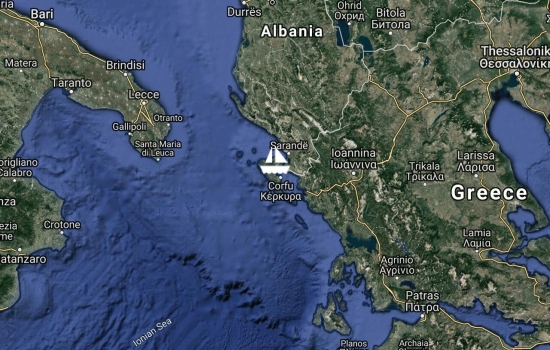
Avg: 3knts
24hr: 71.2nm
At least once before I've awakened in the morning to find Robbie in bed with me and panicked, "What are you DOING here!?" This morning I woke just before 8:00, saw him next to me and remembered instantly that we have arrived in Corfu Greece and just slept twelve hours straight. We're no longer on passage. We can sleep at the same time, together. What a joy, the joy compounded by the sound of raindrops on the deck overhead. Rain. We've seen no rain since October 2018 and the red Sahara sands, sifted onto Mersoleil in the Atlantic Ocean off West Africa, remain on the mast and rig above reach of our hands or hose. First in the task of washing Mersoleil, always covered with salt after a passage, but still adorned with red dust too, will be for me to go aloft with the end of the water hose, once on the forward side, then again on the aft. Even before that, and we're leaving now, we will go pay homage to the Schengen Immigration authorities, Greek Customs and the Port Police. Then, SIM cards, a few groceries, and finally the aforementioned boat bath. I foresee a long sleep tonight, too, after all that.
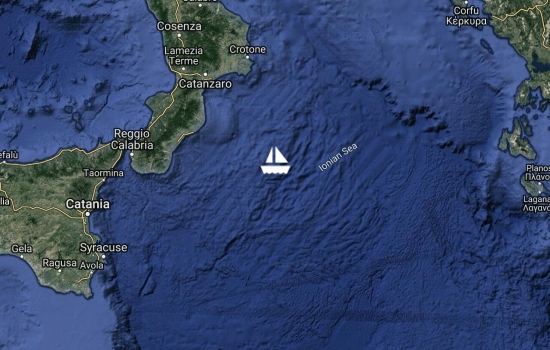
Avg: 4.8knts
24hr: 114.4nm
Nothing quite so exciting as the micro burst has occurred over the past few days. We've luxuriated in warm sunny days, dry nights (for the most part) and low to modest breezes pushing us along around the SE tip of Sicily and past Malta. Now on the last long leg of this passage, our next turn will be at the southern tip of Corfu at noon on Monday if we can manage our speed per the plan.. Dragging our feet tonight in hopes of missing the height of a NNW wind surge that will roar down the Ionian Sea tomorrow afternoon till early Monday, we're sailing with full genoa and reefed main, expecting to have to dowse the genoa and replace it with staysail later this evening. We'll probably arrive at Corfu on Monday afternoon, be too late to clear in and hope we can find a place to drop the hook, then approach Corfu Harbour on Tuesday morning. It's been a wonderful passage. We'll let you know when we touch down.

Avg: 5.4knts
24hr: 130.5nm
Pasagemaking is full of surprises. However well prepared one might be, some new and unexpected lesson or experience invaribaly presents itself for our problem solving enjoyment. I'll tell you about two absolutely new things we've experienced on this passage.
First, this when we were at the eastern end of the Alboran Sea, south of the SE corner of Spain.
It was an evolving story, so I'll give it to you in stages. After entering the Strait of Gibralter, we assumed an easterly course at 36 degrees north, taking advantage of the tattered remains of the westerlies that blow much on the time into the STrait from the Atlantic Ocean. Then at about 30nm off the coast, where the north coast of Africa curves northward, we turned NE to follow along the coast at that distance offshore. We had just crossed the Morocco/Algeria border. PART 1. 0400 local POS 36 05N 001 19W This, we thought, was not an emergency yet, but could become one. Briefly, our heading for the past several hours had been about 37 degrees to port of our actual course. The autopilot would hold a course if set to drive the boat at a specific degree of the compass, but became hopelessly confused if locked onto a waypoint and told GO TO. In that case it grew a gradually increasing crosstrack error. We suspected, and didn't know if this is even possible, that the rudder may be turned on its post, meaning it must be loose. The only reasonable thing to do was to head to Spain for assessment and repair. Best choice would be Palma, Mallorca, where we understand there are superior marine services, but Palma was 285nm away, too far to go in a yacht in even the slightest danger of losing its rudder. Next best choice, and only about 50nm away would be someplace along the Spanish coast.
PART 2. 0800 local This was sooo weird.... We turned on a northerly course assuming we'd head either to the Spanish peninsula or to the Balearics, and things promptly began to resolve themselves. The autopilot cooperatively locked on a waypoint and held the waypoint, keeping crosstrack error to zero. The heading reported by our nav systems was now only about 10 degrees off our course over ground, believable in the SE setting current that had drifted us earlier at 2.5kts while we stopped for a pow wow.
If we hadn't recently seen our own radar jammed by vessels hiding from pirates, visited 2 countries who jammed our satphone, and heard on the news that Isreal accuses Russia of buggering GPS systems at Ben Gurion Airport, I wouldn't even THINK this, but now I began to wonder if the nearest North African country has disabled nav systems along their coastline. What a crazy world.
Our tentative thought at that moment was to proceed in a generally NE direction and watch our systems closely for the next several hours, with the intent to head either to the Balearics for a troubleshooting session or to Greece where we'll do the same later (and at a lower cost).
PART 3. 0930 local This is soooo weird, we thought again. We came to the tentative conclusion that our navigation problems were related to being in the coastal waters of that nearby North African country. Since turning more northerly and building some distance off the coast, most of the anomalies disappeared, although our heading still appeared to be slightly miscalculated, now off by only about 5 degrees whereas at the point where I felt things had gone seriously amiss it was off by 35 degrees.
Since the Balearics were ahead and still east of our current location, we tentatively decided to continue on toward Greece, knowing the stop at Mallorca would continue to be an option for the next 200nm, giving us more than 24 hours to reconsider. We determined to remain away from the coast, out with the big guys again, hanging onto the right edge of the general flow of traffic. At 38 18N 001 07W we still observed a small distortion in our heading, as was obvious when a nearby ship crossed our heading vector on the chartplotter while he was clearly actually off to the left ahead of us. The heading error seemed to be improving, though, with the nearest coastline about 40nm away.
It's unlike us to place our confidence in preposterous possibilities, unlike Robbie in particular, but it's a strange world we live in these days and I guess that might be more apparent in North Africa than it might be in, say, Sweden or New Zealand. Looks like somebody may have buggered GPS satellite reception in their coastal waters.
So, on to Greece, we decided, with a potential diversion toward Balearics kept in our back pocket just in case. 40nm offshore seemed to be the magic number, at least it put us out in the midst of the shipping traffic and nobody seemed to be going in circles out there.
PART 4.
Over the next few days we watched the situation and have confirmed that if we stay 40nm offshore everything works properly. Our rudder is probably as firmly attached as ever it was and when we tack closer to shore, a very unattractive option but if you're going to tack, you've got to go somewhere, we ignore the bad data and sail the old fashioned way, using magnetic compass and the boat's wind instrument, and ignoring all the data involving satellite output. We're still in the area of buggered satcomms and have grown accustomed to working with less data and more common sense. It's a funny world. And we learned about sailing from this.
Oh my! We learned about sailing from another experience, too, on Saturday evening just as it was growing dark.
In keeping with the "All the Exciting Stuff Happens on Bev's Watch" principle, the light easterly wind shifted VERY suddenly, blasted me with hot air, at least a 15F warmer, rose instantly to 30kts from the NW, spun Mersoleil around 160deg and laid her over to such a degree that it threw His Off-Watch Robbiness out of bed. That was exciting indeed, as can be seen from the bow-tie shaped knot in the track laid down on our chartplotter at 17 02N 002 38E. Knowing I couldn't trust anything at the helm except the magnetic compass and wind speed made recovering and controlling the boat an interesting challenge. After that the wind alternated for a couple of hours between brief periods of NW 4-7kts and NW 13-15, these higher winds including more blasts of hot air. Once things were back under control I checked radar. There had been nothing on radar except vessels and land before the wind shift and after there was only a small patch of scattered rain about 7nm away to the SE and that was gone moments later. I felt a couple of drops of rain during the wind event, but not enough to even call it a sprinkle. This was completely new to me. I've experienced something similar with the passage of a cold front, but this air was hot. I asked Bruce Buckley, our meteorologist, "What the heck was that?" I quote some of Bruce's very interesting reply. "What you experienced is what is called a micro-burst. There was a high based shower from the middle level cloud with a bit more oomph than normal. Almost all the rain evaporated before it reached the ground but the winds accelerate with the cooling of the winds. The perfect micro-burst evaporates the last drop of rain right at ground level as this maximises the evaporational cooling. The rain originated from the desert (the winds above the surface were from the SW. The micro burst passed to your NW - but it still contained the desert air - hence the sudden warming as the air came from the Saharan desert). You really need to have Doppler radar to see them at all - with a narrow beam width.
"This is the very same weather effect that hit the US Air Force 1 as it landed at Andrews Air Force base around 3 decades ago and produced a gust near 100 knots. President Ronald Reagan was on board at the time - the event literally scared the Cr@@#$# out of him - and so he funded the nation-wide US NexRad radar program - which lead to something like 100 high quality S-Band Doppler radar being installed across the USA. These high quality radar are the only thing that can warn of these events as they last a very short period of time and the computer models to date still can't predict them. Luckily your micro-burst was a small one." A small one! It was big enough for me!!!! We've been sailing almost all the time for the past 48 hours. Two days ago we feared we'd have to make a stop in Tunisia for fuel, hugely inconvenient to clear into a country just to stay for an hour or so. But now that nice sailing has returned, we're, as Robbie would say, cautiously optimistic that a stop will be unnecessary. The seas have been calm and flat, delightfully blue under clear skies, and we're eating well on this passage. I made time in Rabat to stock the freezer with individual servings of chile con carne, turkey osso bucco with parsley gremolata (lots of recipes online and definitely worth a try), red beans and rice, and other things we can easily scrape together if we tire of the other choices.
All is well. The rudder is fine. The micro burst didn't wreck Mersoleil. We know our nav data will be miraculously cured in another day or two. And we're having fun, even without beer or wine which we'd have purchased in Rabat if we could have found any!
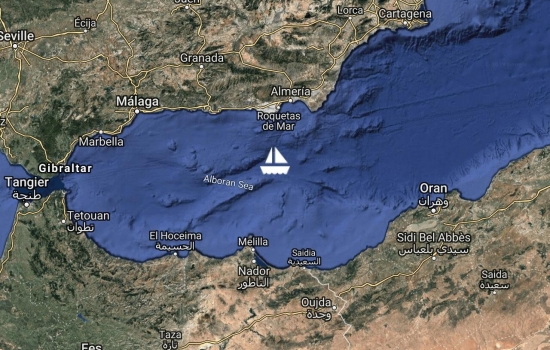
Regular readers of these pages will recognize it, but we had never even heard the cruisers' cliche before we proved its validity in 2011 - cruisers' plans are indeed written in sand at low tide. It was our plan that year, as we prepared Mersoleil and ourselves to sail the world, to head down the West Coast of America to Mexico, then Panama, before transiting the Panama Canal and crossing the Atlantic to the Mediterranean Sea. Later, after spending a year or two in the Med, we would pass back through the Canal and circumnavigate in a Westerly direction. That was the plan until June of 2011, when we looked back over the first half of the year and asked ourselves what on earth we were thinking! Greece and Spain were both on the brink of insolvency, looking to the EU to save them from financial ruin. The Arab Spring had incited new levels of terrorism across Northern Africa. An acquaintance of mine was one of four American sailors killed in March of that year by Somali pirates during an attack gone very wrong in the Indian Ocean. Why, we asked ourselves, would we want to spend time in the most expensive cruising grounds in the world when the entire south coast of the Med was off limits to us and several countries on the European side were angry and preoccupied with failing economies? Two months before we left Seattle, Robbie and I scratched plan A, wadded up the paper, and threw it in the fire. We sailed down to Mexico and turned right instead of left, bound for French Polynesia and the South Pacific! We have never looked back on that decision.
Now fast forward to July 2019 and imagine how we felt yesterday sailing into the Mediterranean Sea in bright sunshine and light westerlies through the Strait of Gibralter. We are thrilled to be here! We're completely different people from the couple who left Seattle eight years ago, but we're just as excited to be in the Med, finally, as we would have been in our first season cruising. Several of our friends have completed their circumnavigations in the last month or two, one couple writing to share their excitement and noting that they had sailed more than 40,000nm in their quest to reach the starting point again. Our goal has never been to complete an official circumnavigation, but we've already sailed more than 50,000nm and we both felt yesterday, passing through the Pillars of Hercules and gazing at the Rock of Gibralter, that we had reached the same kind of milestone. We got here, by golly! The long way.
Mersoleil is in the Mediterranean Sea!
Morocco. We're still pinching ourselves! It's every bit as charming and as magic as we hoped it would be and, with that, our every preconception has been dashed and we found ourselves thoroughly charmed by unexpected joys and magic. The loving friends we've made here, in particular. But also the deeply spiritual focus of the population - I saw a woman this afternoon spread her prayer mat on the dock and drop to her knees as the call to prayer rang through the marina from four or five nearby minarets. And the ancient arts in the old imperial cities and medinas.
Mersoleil arrived in Morocco on a new moon, on the last day of Ramadan, in fact, and will leave tomorrow morning on the next new moon! By the time we reach Corfu that moon will be full again and, as usual, we are elated at the prospect of another passage to someplace new.
Neither of us has ever been to Greece. Not yet.
But wait! What about Casablanca?
More famous from the movie than for its contributions to Moroccan life and culture, Casablanca IS Morocco's largest city and the hub of business and commercial activities. But, as such, Casablanca is not much different from other big cities. The fact that this surprised us is yet further evidence of our misconceptions about the world, another one debunked by reality. On the way back to Rabat we DID make a stop in Casablanca though, to visit the beautiful Hassan II Mosque, the largest mosque in Africa, 5th largest in the world, that can accommodate 25,000 worshipers inside at prayer and another 80,000 outside on the plaza.
The minaret here IS the highest in the world, soaring sixty stories into the sky at the edge of the Atlantic Ocean. At night a laser shines across the sky pointing directly toward Mecca. The Hassan II mosque complex, completed in 1993, is majestic and beautiful. Have a look!
Marrakesh Continued June 16-17 2019
Cuisines of the various countries we visit fascinate us both. I love to cook, Robbie and I both favour piquant and exciting flavours and we're game for trying most new and different foods, hence my recipe subdirectories entitled 'Kangaroo,' 'Octopus,' Tapas,' 'Indian' and 'Tagines.' Some of my tagine recipes date back as far as 1978. When stopping in a culture whose cuisine we particularly enjoy, I participate in the best cooking class I can find. I'd already explained to Alecia that I didn't care to spend half the class touring the vegetable souks, or watching suburban housewives learn how to use a knife, or contribute nothing but 7 cups of finely chopped onion to a complicated meal that I wouldn't understand after dedicating 2/3 of the class to chopping onions, and she directed me to a wonderful cooking class in a state-of-the-art purpose-built kitchen at Riad La Maison Arabe.
Twenty participants wasn't too many for this class, a very unusual thing. Each had his own complete prep station in the class kitchen, sharing a sink, waste bin and large display monitor with the person next door. Most of the ingredients were already measured and in place, and we got right down to the business of preparing a classic Moroccan dish, chicken tagine with preserved lemon and olives, and two Morrocan salads, which we'd call side dishes in the US. They were not heaps of lettuce, in fact no lettuce was involved. At the head of the kitchen on a raised dais with strategically-placed overhead camera, the Dada Chef, a traditional Moroccan chef, (usually a woman, and a woman in this case) prepared the same dishes, demonstrating technique, touring the kitchen now and then with tips and encouragement, accompanied throughout by the detailed narration of an English-speaking translator. To see what she was doing close-up, we needed only to look at the monitors in front of each workstation, a la French Chef.
In less than two hours we'd all prepared a wonderful complete meal, slapped our name tags on our own tagine lids and adjourned to the charming dining room to feast, to the accompaniment of live Moroccan guitar music and song, on the meals just prepared. Those sides, by the way, were a Taktuka Salad of grilled chopped green pepper, chopped fresh tomato and onion, lots of garlic Moroccan spices and olive oil, and Zaalouk, a combination of garlic, spices, aubergine and tomato cooked to a rough paste and scooped up with chunks of fresh bread. (Chef made the bread while we were busy with other things - she's quick.) I've taken lots of cooking classes. This was the very best, even if it did conform to the ridiculous First Commandment of Cooking Schools, 'Thou shalt not use a sharp knife for thy cooking class.' I'll never understand that. You can kill yourself with a dull knife.
The people were a nice group, too, and luncheon was a delightful affair served amid lively conversation with wine for those who wanted it.
Alecia left the afternoon free with the subtle suggestion that a visit to the riad hammam would be a nice relaxing experience. I wanted to do that, but overwhelmed with guilt for having so much fun while Robbie and his flu had demurred to attendance at a cooking class, we enjoyed the remainder of the afternoon together relaxing in the garden and our room.
Three Days in Marrakesh - June 15-17
Does it get any more exotic? Not for us! On our last night in Fes, Tahar said, "What do you want to do tomorrow? We can leave early and drive through the Middle Atlas Mountains, the long way, nine and a half hours. Or we can leave later and take the highway." Robbie and I begged for the longer, scenic route and we pried ourselves away from charming Riad Amor after an early breakfast, followed the desk clerk to Tahar's Toyota which we would never have found on our own, and buckled our seatbelts for the long ride to Marrakesh.
Still wrestling with the flu bug, a long leisurely sit seemed just the ticket anyway for people a bit low on energy, so we tucked into the back seat and watched the Moroccan countryside pass by, again on excellent, if secondary, roads. We never think of these vehicle transfers as just another long drive. Instead, we use them as exciting opportunities to explore the countryside, to see people going about their daily tasks, to inquire about the agriculture, the animals, the wildlife, the power grid, the climate... At what time do most people eat their meals? (7AM, big meal at 2ish, tea at 6, small supper at 10:30 or 11) When do they go to bed? (midnight) What is the source of the water supply? (the mountains, then tall cylindrical water towers) Why isn't that child in school at this time of day? (exams just finished last week) What's growing under those nets? (Peaches, apricots). I asked Tahar if most tour guests choose the scenic route. "No," he said, "most just want to get to Marrakesh and we go on the highway." Shame, I thought.
Olives grow virtually everywhere, in long tidy rows of healthy trees. As we rode along we could smell the distinct scent of olives on the breeze, something I've never smelled before in places where olives are grown. I don't know why it surprised me that they smell just like, well, ...olives. They won't be picked, and hand picked at that, until October, but they smell now exactly like the fragrance that wafts out of the jar of olives in our fridge when one removes the lid.
Another thing that left a deep impression on me was the charming town of Ifrane. I had no business nursing preconceptions of what might be found in Morocco, but this cozy little Alpine village surprised me with its cedar forests and steeply pitched roofs, the better to shed winter snowfalls. Ifrane is perched at 5,500 feet above sea level, (1,670m) and is a popular holiday location for overseas tourists and for Moroccans who want winter fun or cool breezes in the summer. While the population changes daily with people coming and going from resorts and second homes, the census believes there to be nearly 75,000 people enjoying the clean air and gentle pace of Ifrane.
Fruit orchards and olive groves abound along the drive to Marrakesh, the fruit gradually giving way to arid rolling plains as we move south into warmer air. We passed a Moroccan army convoy, plenty of petrol stations, many farm implements - it's hay cutting/baling season - making their way down the road, and some dogs, finally. Cats in the cities. Dogs in the countryside, I guess.
Entering the city of Marrakesh, we listened to Tahar's litany of how easy it would be for us to walk to this square or that hotel or the other historical site from our hotel, until after the next ten turns and a few more kilometers Robbie and I looked at each other with "I am NEVER going to remember that" in our eyes. Marrakesh including its medina is several hundred years younger than Fes, as is apparent in wider streets and larger public spaces, and it has a completely different vibe. We went directly to our hotel that evening, Riad de les Jardins de Medina, and were warmly welcomed with cold damp towels with which to refresh our faces and complimentary drinks in the delightful courtyard garden. It would have been nice to find ourselves amoung Moroccan guests, but what, really can one expect from a hotel? The Moroccans tend to live in their own homes while in Morocco, and we contented ourselves in the elegant colonial-style riad amoung other American, French and Spanish guests. The availability of a full bar came as quite a treat in this land of alcohol-free living and I sipped two Aperol Spritzes, my latest favourite summer drink, while Robbie tried an Absolut Martini on his rumbling tummy, olives on the side. Alecia had selected another wonderful accommodation for us. We found our room to be delightful and took some pictures of decorative details we'll want to remember for the future.
Exploration of Marrakesh began in earnest on the next morning with a stop at the renowned Majorelle Gardens, Jacques Majorelle a French ex-pat painter of small note outside Morocco, but son of celebrated Art Nouveau furniture designer, Louis Majorelle. Mr. Morelle the younger met a sad end shortly after a 1962 automobile crash at which time Yves Saint Laurent, a designer of whom we have all heard, purchased the property and the gardens, refurbished all retaining the Majorelle Blue accents and opened the gardens to the public. A great lover of gardens, I was enormously amused to discover the Majorelle Gardens filled with all the desert plants I know well from Phoenix, El Paso and Northern Mexico! It was like bumping into old friends halfway around the world. Igave them all virtual hugs but did not take pictures.
Adjacent to the gardens the Yves Saint Laurent Museum, complete with research library, bookshop and cafe, displays a permanent exhibition of the great fashion designer's sketches, notes and at least a hundred finished fashions ranging from the basic black he favoured early in his career to the vibrant colours of Marrakesh which inspired his later creations. Sadly, photos were not allowed. This museum is definitely worth a visit!
Even better, and not far away, is the Berber museum honoring the people and traditions of the Berbers, Morocco's earliest known inhabitants, who were driven up into the mountains in the 7th century by Islamic invaders. Beautifully presented examples of tools, jewelry and traditional clothing, both men and women's, highlight the vast differences in culture and tradition between the Arabic, Moorish and Jewish populous of Morocco and the native Berbers. One feels here like one has climbed into the pages of grandmother's copy of National Geographic. No cameras allowed here, either, to my great disappointment.
We completed the day with a brief visit to Koutoubia Mosque and Gardens, the largest and grandest in Marrakesh and a tour of the Bahia Palace built at the turn of the 20th century and featuring carved and painted cedar ceilings, a different design in each of its 164 rooms. One needs to exercise some creative imagination to see tapestries on the walls, carpets and furniture on the floors, but the celings are indeed remarkable. Typical in Moroccan architecture, the rooms are wide and shallow, each facing onto an open courtyard for the best exposure to cooling breezes and the plash of water in the fountains.
A late lunch, late for us anyway, at 2:30 or 3:00 completed our first tour of Marrakesh and we returned to the oasis of Les Jardin des Medina (I think that's right), for a preprandial nap and cocktail, then dinner by the pool. We felt very pampered and slipped between the sheets by nine in order to be ready for another day on our feet. We do sometimes notice that we are no longer thirty-five, closer to twice that.
Greetings from Fes, Morocco. June 12th-14th.
As near as we have been able to gather Fez is the district in which the city of Fes is located. One of them is also a hat and remember, these letters have nothing to do with Arabic words, so I think you might use either spelling with impunity.
Fes is rich in culture and history, having the oldest vibrant medina in the world - in addition to royal palaces, monumental gates, the oldest Jewish Mellah in Morocco (neighborhood, ghetto) and an abundance of age honored crafts. Three days in Fes inspires one to plan a next visit. It's cool, by the way, in June in Morocco. We have not gone so far south as the Sahara where it must be very hot, but in Rabat we're sleeping under a duvet at night and often pile a heavy fleece blanket on top. We found both Fes and Marrakesh (further south) perfectly comfortable in the shade and quite warm in direct sun. Arid but not bitterly dry, we were comfortable throughout our tour, finding only the late afternoon sunshine something to be avoided.
Every single picture you see here was taken inside the medina, except for the one or two that say "Overlooking the Medina." It's a lively vibrant community with the market streets bustling and jam-packed with people and products. The residential streets, like the one on which you see Robbie standing at a doorway chatting with our guide are narrow, quiet and labyrinthine. There's more to Fes, the Ville Nouveau, for instance, built and populated in 1912 by the French when they colonized Morocco, and shopping malls, office buildings and whatnot else one might expect in a big city. But it's the medina that holds the charm and the mystery, and to those who enjoy living according to the old traditions, the medina is home. Property values soar in the medina.
Below, photos of the Fes medina stalls, markets and artisan cooperatives speak for themselves. It escapes me why I failed to take a picture of the camel meat sellers, two in the medina, who butcher a camel and hang its sorry head above the stall to show that there's fresh camel meat today. Camel meat, more expensive than beef, is a delicacy and I did not have an opportunity to taste it, but would have gladly done so. In addition to prowling the fascinating market streets, crowded, lively and mostly covered lattice roofs to keep them cool, we visited the gates near the royal palace, Bab Boujloud, blue on one side and green on the other; the 17th century Ibn Danan Synagogue in the Mellah, nestled against the wall of the royal palace for the protection of the Jewish inhabitants; Bou Inania Madrasa, one of the oldest Koranic schools in Fes, opened in 1355 and acknowleded as one of the finest examples of Marinid architecture; and the University of Kairouine (or al-Qarawiyyin, also written Al Quaraouiyine or Al-Karaouine) an important center of Islamic learning since 859 and the oldest continuously operating university in the world, so say UNESCO and Guiness World Records. There is much to see and do in Fes.
Robbie took a day off from touring to nurse a persistent case of the flu (that I gave him) while I joined local tour guide Miriam for a Fes Food Tour wherein we tasted olives, dates, wild honey, bissara (a fava bean soup served at breakfast) and Moroccan mint tea. We visited a 400-year-old furan, a wood-fired community oven that not only bakes the bread kneaded at home and delivered on trays from each household, the colorful towel over the dough to identify whose bread is whose, but also heats the water used at the neighborhood hammam, the traditional Moroccan bath.
Moroccans consider the hammam an essential luxury, time to relax, and for women an opportunity to socialize with their friends. Two kinds of Hammams are common, the steam bath, patterned after Roman tradition, and the hot water bath. Both are usually accompanied by an exfoliating scrub and/or massage with local oils and spices. There are some 250 hammans in Fes. No, I didn't.
It would be impossible for us to find our way around the medina in Fes, or the still larger medina in Marrakesh. Fortunately, help is available everywhere. A man came from Riad Amor to meet us at Tahar's car upon arrival. He carried our single bag and led us directly to our room, several blocks away through twisting and turning 'streets', far too narrow for any vehicle except a motorcycle. We'd have NEVER found it on our own.
It's hard to believe we squeezed more into the first day of our Morocco tour, but Moroccan highways are excellent and it's only 95 miles from Rabat to Meknes. Charming local guide, Atimade, an accomplished painter herself when she's not showing visitors around her hometown, took us to see artisans and their crafts, available only in Meknes. Geometric embroidery on cotton and linen is handsome and popular and the exquisite silver Damascene in the picture below is created only in Meknes.
Meknes, another Moroccan Imperial City, boasts ruins from the times of the Romans, including the Royal Stables, built to accommodate 12,000 royal horses and massive graneries large enough to supply both horses and the population.
Atimade was the highlight of our visit to Meknes. We hope one of her beautiful paintings will grace the wall of our next home! She says she'll deliver it in person, a great excuse for a visit! Our stop in Meknes was much too short, but we carried on another 40 miles to Fes and a lovely suite at Riad Amor in the heart of the Fes medina.
If we've learned anything in Morocco, it's that there is much to see, to experience, to absorb, and this cannot be accomplished in seven days. But we did what we could in a long week, taking advantage of the truly excellent services of Travel-Exploration.com. Alecia Cohen planned our delightful tour, arranging a congenial driver, knowledgeable English-speaking guides, a fascinating itinerary and lodgings in traditional Moroccan luxury, while accommodating our preferences and interests. Great job, Alecia! Thank you!
Tahar, a warm, friendly Berber from Agadir, further south on the Atlantic coast, picked us up this morning in his Toyota Land Cruiser at the Bouregreg Marina. Most tours begin in Casablanca, but since we were here, why not visit Rabat before moving on?
When I shot a picture of the Oudaia Kasbah from the sea as we entered the Bouregreg River (BOO ruh greg) I failed to appreciate the vibrant blue and white residential neighborhood visible just behind the anocient walls. Since the kasbah was originally built in the late 17th century it has been renovated, conquered, destroyed and rebuilt numerous times and now consists of the original citadel with its impressive Bab Oudaia (bab=gate), sought-after traditional homes, Chellah ruins including even some Roman ones, the King's Palace and more. Highlights for me included the intoxicating fragrances of blooming plants (do visit in late spring if you can!) and the storks nesting atop minarets, towers and parapets, especially in the oldest ruins. Baby storks were standing on every nest, flapping their wings, trying to get the hang of how they might work, anticipating a successful fledging any day now!
Nearby stands the impressive, but never completed, Hassan II tower commissioned in 1195 by Caliph Abu Yusuf Yaqub al-Mansur and planned to be the largest mosque with the highest minaret in the world. When the Caliph died in 1199 construction was stopped, the minaret only half its intended height.
Sharing the espanande with the Hassan II Tower, at its opposite end and featured in the photos below that show new construction, is the mausoleum of King Mohammed V and his two sons, the late King Hassan II and Prince Abdallah. The building is considered a masterpiece of modern Alaouite dynasty architecture, with its white silhouette, topped by a typical green tiled roof, green being the colour of Islam. A reader of the Koran is often present, having his assigned seat. Its construction was completed in 1971 for the internment of Mohammed V who had died ten years earlier, and King Hassan II was buried there following his death in 1999. Handsome young Moroccan military guards, happy to have their photos captured by visitors, stand throughout the mausoleum and guard the gates astride horses.
All this in half a day, then we were off to see the Imperial City of Meknes (mc NESS). (I give you pronunciations sometimes because Robbie and I have been getting them wrong until we finally reach a place and are surprised to hear the locals speak!)
Peter Streit left Las Canarias a few weeks before we did, stopped in Rabat, and gave us the skinny on Bouregreg Marina before we arrived here. "I met this great guy named Noureddine," he informed us, "and I've given him your whatsapp. You will like Nouredinne, you must meet him. He will contact you."
And so Day 3 in Morocco began with Nouredinne who arrived an hour late for our 10AM get together. Or so we thought. In fact, we hadn't considered what time zone might be observed in Rabat, though I vaguely remembered something about Ramadan time reverting to GMT. That can't possibly happen everywhere, I thought... Mecca isn't even on GMT. But I don't have to understand these things. We were sitting on a bench at the end of Dakhla Pontoon, Nouredinne was late, and we waited over an hour until his punctual arrival at 10AM, we being completely ignorant of the correct time. We got that straightened out with Nouredinne's help, then he drove us to the Marjane Supermarket.
Marjane supermarkets are enormous and carry everything from auto supplies to beach towels to lamps plus a complete line of groceries and fresh foods. They are much like large Carrefour stores sans the adult beverages and helpfully provide multilingual labelling - in Arabic and French, neither much help to me. Fortunately Nouredinne was there to translate further and the provisioning trip was hugely successful. My favourite department is always the produce department, where I need little linguistic assistance except for root vegetables, and since I tend to avoid those altogether beyond carrots and beets, I was happy on my own while Robbie and Nouredinne sought Diet Coke, yogurt and other things whose labels required deciphering.
Never before, anywhere in the world, have I found more beautiful fruit than at the Marjane in Rabat! The peaches smelled like peaches, ripe and juicy. Golden apricots were eat-today ripe, as well, unblemished and piled high in tempting mounds. I bought more fruit than ever before in a single go and immediately upon returning to Mersoleil bit into a sweet, blushing, succulent peach whose juices ran down my chin despite my efforts to be tidy! The best fruit in the world!
The boys dutifully delivered our provisions to the boat, then, while I stowed (and ate peaches) they took themselves off to the coffee cafe, a time-honored Moroccan tradition where men spend leisurely days, absent the company of their wives, in conference amoung themselves about things of little moment.
Farid chatted with us the other night at the Orange shop, saying he's originally from Rabat, now lives in Pennsylvania, and he comes here to visit his parents every year at the end of Ramadan. His son would be flying in for a short visit as well, and he is always happy to spend time with his family. What's that, he asked? You live on a boat? What do you mean? He could hardly imagine.
Thus, later in the afternoon Robbie returned from the coffee cafe to receive guests Farid; son, Youssef; and brother Chakir, all of whom found the very idea of sailing around the world on a yacht like this thrilling and original. We had a warm and happy visit for a couple of hours, exchanged contact info and agreed to keep in touch. I served Moroccan coffee, which was dreadful, but hey! It was my first try and I forgot to watch how long it brewed so it was weak and watery. It's supposed to be strong. Not mud, like Turkish coffee, but at least dark and rich. Next time I'll do better.
We are deeply touched by the warmth, the hospitality and the generosity of the Moroccan people.
OK. I fixed my phone. I didn't even KNOW I could change the aspect ratio on the camera. From now on it will be 16:9. Sorry.
Ramadan Breakfast in Rabat, the breaking of the fast
First on the agenda after checking in to a new country is to lay our hands on some local currency and SIM cards, necessary more for data than for telephone calls in a place where, presumably, we know no one. I spent Day 2 washing the boat (LOVE the new power washer!) while Robbie walked to the Sale medina (SAH lay) in search of ATM and Orange cellular shop. He found both while I cleaned evidence of a salty passage off the boat and by midafternoon we settled inside curious to see how hot it would get in Rabat. Not bad, it turned out. The weather during June in seaside Rabat is absolutely lovely. Cool at night, comfortable during the day.
"Oh," mentioned Robbie as he sat at his laptop, "We have been invited to a celebration tonight at the home of the lady at the Orange store. Won't that be fun?" I demurred, tired from five hours of work on deck, but at 7PM my phone rang.
"You must come to see how we celebrate the end of Ramadan. This is a very special meal and we do not do this every day."
We walked to the Orange store, Loubna closed up the shop, then she and her two daughtes led us through the labyrinthine medina to their beautiful traditional Moroccan home and we settled to an incredible meal, as you can see. Everything was delicious and I know the name of only one dish. The lentil soup, traditionally served to break the fast, is harira, as I learned from my reading the following day.
The beginning and end of Ramadan are based entirely upon the moon, the ninth month of the Islamic calendar. It begins the morning after the crescent moon is first visible to the naked eye, but the end of Ramadan officially occurs at the very moment the first horn of the crescent new moon next rises. This is a very local event and it's impossible for people nestled in the ancient multi-storied homes of the medina to see that tiny lunar ascencion. So they watch television throughout the Ramadan Breakfast which began at sundown! We thought it odd that there was a TV blaring in the same room where we feasted, but suddenly the announcement was broadcast, "Eid Mubarek Seid!" and everyone got excited and started Eid Mubarek Seiding one another, and Loubna grabbed her cell phone and began to call distant family and close friends to congratulate everyone on the completion of a month of prayer and fasting.
Day 2 in remarkable Morocco and we already have family in Rabat. "Our home is your home," said Loubna. "Anything at all you need, you come to us. Are you coming here for lunch tomorrow?"
Avg: 3.3knts
24hr: 79nm
Conditions were just about perfect for the 500nm passage from Arrecife to Rabat. Trade winds normally blow strong and constant from the NE at this time of year and NE is, of course, exactly the direction in which we traveled. But periodically the winds soften, and every now and then they swing N or NNW, and we made an easy passage under these more favourable conditions, motorsailing most of the way to increase our speed and make landfall in Morocco before the winds turned again and strengthened.
Dawdling offshore overnight, we called Bouregreg Marina at about 9AM and they sent out a pilot in a small boat to guide us across the bar, often rough and sometimes closed. The low low tide occurred at 0904 and we were skeptical about entering a shallow bar at lowest astronomical tide, but the Capitaine encouraged us saying, "no problem!" We followed precisely in the wake of the piot boat... and had at least five inches of water below the keel at the shallowest point. Not surprising, really. It was the last day of Ramadan, whose date is determined each year by the lunar cycle, so we knew a new moon was only hours away.
Clearing into the country of Morocco was a simple matter completed in under an hour at the police dock in the marina. The police, port, immigration and customs officers all came aboard, we filled in a couple of forms in Arabic/French (that was interesting) and a no-nonsense black German shepherd strolled around on deck sniffing for contraban and was disappointed. Since the police dock doubles as fuel dock, we replenished our diesel supply then moved to a berth on the end of Dakhla pontoon. On the wall in the Capitaine's office, typical in all marinas, there's a whiteboard showing the marina layout together with the names of all the vessels berthed there. Next to each name on this whiteboard, and not so typical, is a small graphic of the vessel's national flag. Nine foreign flags appear there, the stars and stripes displayed only next to Mersoleil. We're probably the largest vessel here, too, most of the boats being small power boats or little daysailers, and each afternoon we hear lots of happy locals chatting as they visit their boats or go out for a short ride, the kids venting their energy by running up and down the docks.
Lunch at one of the several marina restaurants was fair at best,but we were tired, didn't care, and ended the day with an early bedtime.
Greetings from Arrecife, Lanzarote, Las Canarias, Spain
We don't exactly understand why we like Lanzarote so much better than Gran Canaria. Others, we understand, feel the opposite. But we've been warmly welcomed here; the marina is beautiful; everything in town is within walking distance, including several nice restaurants; and, well, maybe Arrecife just has a happier vibration.
Sailing 'the long way' from Las Palmas to Arrecife, we passed south of the island of Fuerteventura which protected us from strong N winds, and we arrived on April 26th. What have we done in the 4 weeks since then? It's hard to say! I know I spent six days servicing all the winches in the cockpit. They were due for servicing anyway, and had become so full of desert dirt from the Harmattan winds that I dared not wait any longer. Here we're safely north of those gritty winds and now that the winches are clean and greased, I dearly hope we'll have no more sandy winds in Morocco!
My procedure for servicing winches is to disassemble them right down to the fiberglass, or down, at least, to the base plate that's bedded onto the deck. As I remove each piece, bearings and gears, pawls and springs, clips, bolts, collars, axles, top hats and posts, I clean it with diesel fuel, toothbrush, Q-tip, toothpick and Scotchbrite and lay it carefully in the exact sequence in which it was removed. This not being sufficient to help me remember from whence every single piece came (there are as many as eight or nine gear wheels and 5 sets of bearings in each winch) I take pictures at nearly every step along the way to help me remember how to reassemble! When I do this frequently I have no trouble remembering how each one is assembled, but I learned several years ago that cleaning them every six months was more often than necessary.... and my memory doesn't seem to work beyond six months! After disassembling and cleaning, I apply white lithium grease as I put the whole thing back together. I have almost no pictures of nice clean newly greased parts - there's no need to record reassembly and it's a huge hassle to stop and clean my hands before picking up my phone for a photo. Dismantling a unit with about 100 small parts has a way of motivating me to wipe my hands for pictures!
Robbie busied himself all week polishing stainless and completing other tasks on our now short list of TTDs. It's been a very productive stop in Arrecife!
Maybe it was the diesel fumes and the fact that my hands were immersed in it for six days, but I've spent most of the last week in bed with headaches and a complete lack of energy. Diesel poisoning or perhaps a little flu bug. In any event, the two winches on the mast still await my attention. These are the two I really dread cleaning. They're installed horizontally and I work on them in constant fear that I'm going to drop a part and hear it bounce click, click, ploop into the water.
Volcanic activity - within geologic memory - created this island. Pockmarked with craters, hot and dry, it's barren of plants and I could never live here, though fields of rough red boulders as far as the eye can see make for a fascinating, if surreal, landscape. The old town is quaint and charming, the streets filled with small cafes and people strolling on weekends, and on Saturday mornings there's a superb produce market in the plaza at the door of the church. The sea is just a block or two away on one side and on another the lagoons that harbour small fishing boats are surrounded by charming promenades, these, too, filled with one's choice of cafes, bars and restaurants.
Electric scooters have become such a craze on continental Europe that they have been restricted or banned in places like Paris where careless riders have mowed down one too many old ladies. They're still popular and unrestricted here, though, and you can pick one up anywhere in town, scan the QR code on the scooter, then your credit card, and have fun for pennies per minute. See wind.co and the pictures below.
Oh, I went up the mast one day, too, to inspect the rig and, I'll be honest, to have a good look around. So there are a few pics below from above, as well. I can't seem to keep my foot out of those pictures... I think it must be essential to remaining vertical or something. I don't believe I've ever taken a photo of Mersoleil from the top of the mast that does not feature my footwear. Sorry. BTW, those are Crocs! I love them.
Late this week we will sail to Morocco, stopping at Rabat, the capital. It's close to the Strait of Gibralter and offers a secure marina where Mersoleil can have some time to herself while we take a tour inland to Fes and Marrakesh. Ramadan continues through the first week of June so we've delayed our arrival there until everyone is back in the usual swing of things.
Avg: 5knts
24hr: 119.5nm
Las Palmas, Las Canarias
Las Palmas is a funny place. Our Swedish friends, Peter and Eva on Tina Princess, (more re Tina Princess later) love it here. They left Mindelo two days after we did en route to the Canaries where they plan to sell Tina Princess and buy a home after 23 years of living aboard and cruising the world. Their enthusiasm for Las Palmas tempted us to consider it for the FRP in lieu of Madeira just 400 miles away. Robbie, in particular, was tempted because his Spanish is a lot better than his Portuguese. I've been studying Portuguese sporadically for 2 years now (I'm on the 8th CD, don't you know) so I'm a bit ahead of him and I can at least make a dinner reservation over the phone, ask the price of something and announce that I need or I want something, although I may not be able to say exactly what it is that I must have. Anyway, suffice it to say that Las Palmas, based on Peter and Eva's enthusiasm, was tempting until we got here.
Marina Las Palmas, with 1500 Med mooring berths, is huge, even bigger than Shilshole Bay Marina where we lived in Seattle (1400). It's run by the Spanish government and is the most affordable marina in Las Canarias, always packed to capacity, and the biggest problem encountered by marina staff is how to accommodate new arrivals, especially foreign yachts passing through. There's no room for them.
Under these constantly overcrowded conditions, the staff adopts the unfortunate attitude that arrivals are an inconvenience, not to be trusted, and to be evicted at the earliest opportunity to make room for the next unwelcome visitor. Peter and Eva, we thought, must have based their love of Las Palmas on some other relationship! First we were told that we could stay - on the reception dock - only overnight then we must move on, they didn't care where. Nice, huh? But our usual charming and compliant behaviour (you never know exactly how to appeal to the local culture when making first landfall in a country, so sweet and humble are important attributes to display) was noticed by the marinero who assisted us at the reception dock.
He came to us a few minutes later with, "Did you see that boat just leaving as you pulled in? I called the lady and they will be gone for a week. What luck! You may have their berth for six days, no more." Of course, we took it! We wanted to experience Las Palmas!
There were a few fires to put out, as is true after nearly every passage, and this had been a fairly long one, 1000nm to windward. Plus, with Santa Semana, Holy Week, eating up several upcoming workdays, (not to mention checking into the country, which was a joke but consumed an entire day) we were unable to get Mersoleil ready for departure in less than six days. (Apparently marina staff, on top of the rest, is totally insensitive to the fact that we arrived sleep deprived and lost ten hours immediately after arrival to correcting that condition.)
Robbie had trespassed upon the office to check us in upon arrival, at which time the ladies behind the desk bit his head off so ferociously that he declined to return there to beg an extension. "You do it. They already hate me."
I went to the marina office with my sweetest, most apologetic demeanor and had no trouble obtaining an extension until April 26. "You're sure you can finish your work in two weeks?" Of course not, but, "Yes."
This is skipping ahead, but it will finish the subject of 'Las Palmas marina staff will not win Ambassador of the Year.' When I came back four days before the named departure date to say high winds would prevent us from departing on the 26th, but we could leave two days later, I was met with, "You pah RAH missed you would leave on the 26th!" Nice, don't you think?
Aside from that, we had a very nice time in Las Palmas, found some fantastic restaurants - and we have been starved for years for good Mediterranean food, especially olives - made a wonderful new friend in Peter Streit on Vela Tonka, and enjoyed wandering the quaint old town around Santa Ana Cathedral. On Good Friday we attended the Procession of the Mantillas in which girls and women of the parish, wearing white lace shawls over their heads, accompany holy objects through the streets. If I was still in Thailand I might have said "effigies of the crucified Christ and the blessed virgin she dressed in her perennial blue gown," and watching the procession pass I realized how similar religious processions are around the world and how their meaning is minimalized or lost altogether on the uninitiated. The Cathedral is lovely inside. It's not one of the great cathedrals of the world, but bears its age with dignity. Just days after the fire at Notre Dame, the presence of heavily armed police scanning the crowd made us poignantly aware of the disorder in which the world exists today.
We attended Easter Mass at the Cathedral, too, surprised at how few people participated in the 1:00 Mass. It reminded me of my parish in Chicago in the '70s. Just the old ladies and my family.
Dining is outstanding in Las Palmas, particularly in the picturesque restaurants of the old town, their tables spilling out into the streets. My foie pate with apple/cinnamon chutney at Los 5 Sentidos was terrific. And there exist at least half a dozen other wonderful eateries just a few minutes stroll from Mersoleil, berthed stern-to on T-pontoon.
Do you wonder what has happened to my spelling? I do too sometimes and I frequently think of this as I write to you. I've been exposed to so many versions of the English language over the past eight years that I can't remember how to spell anything anymore and I know my spelling vacillates back and forth, between, for instance, color and colour, depending upon where I've been most recently. We've even taken to calling the lightweight metal aluminium, convinced by others that America made the mistake of misspelling the name of their own discovery. Whatever.
Las Palmas is a huge city. We were surprised to learn it's the fifth biggest city in Spain. With 500,000 people and little green space, it's definitely not our cup of tea. Funchal has all the charm and quaint homeliness (look it up, it's a funny word) we seek in our next home. Las Palmas does not, but we'll be happy to visit Peter and Eva once we're all settled on our respective islands!
Note the replacement of Doggie1 in Las Palmas with Doggie2, much smaller, a PVC Highfield 260 nicknamed 'the Puppy.' We had so hoped Doggie would make it another year or two, but alas twas not to be. If I say more I'll burst into tears.
We will depart Las Palmas as promised (rev 2) on Monday morning, April 29. We dare not stay.
Avg: 4.1knts
24hr: 99.6nm
Continually amazed by the great opportunities placed before us for safe and easy passagemaking, we DID tack to the NW after the first, easy, four days of this passage and were surprised to find the seas remained comfortable even in 20-22kts winds, permitting Mersoleil to sail to the NW close-hauled and stable for a couple of days. Unfortunately, one doesn't make great speed toward one's destination that way, especially with a reefed main and staysail (expecting trade wind squalls to pop up at any moment, although only one actually presented itself at our location). Making as little as 2 or 3kts over the ground, one begins to think that a destination more than 300nm away, and perpendicular to our course, is unattainable in this lifetime.
But wait, there's more! Yesterday morning early, the winds dropped below 10kts and the sea, which had never been higher than 2m, dropped to nearly flat again. Cured of proving that we can sail, we celebrated the possibility that we'd reached a predicted area of light fitful breezes in the far distant lea of Gran Canaria and cranked up the engine to motor sail straight toward the island, still 300nm away. This light-winds-in-the-lea-of-the-island condition was confirmed by Bruce Buckley in his early morning weather update yesterday (in daily response to our earlier morning position report). He congratulated Mersoleil upon getting far enough North to reach the next region of moderating trade winds, suggesting that if we could keep within that and the lea of Gran Canaria, we had a good chance of running this way right up to the Canaries, hiding behind the high volcanic islands and pushing directly toward our destination. Hurray! Today, the 9th, at noon local, we're still motoring and making progress at 5-6kts instead of 3. At this pace we'll arrive at Las Palmas tomorrow late in the day, far preferable to tacking for another 5 days! It's on passages like this that our minds eventually turn to musing, obsessing sometimes, over odd things. For Robbie at the moment, it's either the care and feeding of lithium iron phosphate batteries or calculating exactly how much fuel we consume under differing conditions between the auxilliary engine and our 6kW generator, thus CAN we sail all the way to _____? For me, today, it's the throbbing in the fingertips of my right hand.
When is the last time you slammed your fingers in a door? I haven't done it in years, I can't even remember the last time, but this morning as I climbed down the companionway ladder at the end of my 6AM watch, I reached over my head to slide the heavy hatch cover closed just as Mersoleil dived nose-first into the trough between two waves. She slammed the companionway cover open instead, using my fingertips to cushion the heavy bang of the glass and steel 'door' as it smashed into the forward frame at the front of the companionway. Oh, my. I stood on the ladder for a number of moments in stunned paralysis, aware of nothing but three painful fingertips, the throbbing beginning almost immediately. Gee! Wow! Yikes. Are you with me? Don't try this at home.
One nail will probably turn that pretty black color. It's already purple on the pad side and 3 or 4 degrees warmer than its colleagues. Ew. I wish I could have that moment back. Another subject of current deliberation, for both Robbie and me (I don't imagine he's obsessing over my finger, but his sympathy is noted with approbation), is the FRP. We're already committed enough to buying a home in Portugal that we've hired a lawyer, obtained tax ID numbers, opened a bank account and looked at real estate on Madeira. But friends give the Canaries such rave reviews that we cannot but be tempted to look there as well. We shall see how it strikes us over the next month or so. After all, is it not true that cruisers' plans are written in sand at low tide? Besides nosotros, los dos, hablamos ya espanol (we both already speak Spanish), and it would be convenient not to need to master a new language, a prospect Robbie in particular doesn't fancy. Either way, I'll have to find the keyboards on my phone and laptop that contain accent marks. Surely the Spanish and the Portuguese don't have to bring up their symbol libraries every few seconds.... but that research can wait..
Life is good. We're happy, pretty excited that this passage is drawing to a close, having fun, and sending you our love.
Avg: 4.7knts
24hr: 113nm
Amazing! We've sailed nearly halfway from the Republic of Cabo Verde to the Canaries, sailed mind you, direct to the NE in the trade wind belt! The trade winds went into hiding for a few days thanks to a low pressure system near Madeira and we've taken great advantage of the lull they left behind, sailing close hauled in 8-15kts of N and NW breeze, so far without a single tack! Along with the nice conditions, the northerly winds carry fresh clear air and Mersoleil has been spared additional polishing by the Harmattan sands from the Sahara Desert. It has truly been a delightful four days so far.
Late this afternoon, the winds are expected to clock to the NNE, then NE, forcing us onto an easterly course or even, God forbid, a southeasterly one. At that point, we'll reduce sail in prep for 20-25kt winds, tack to the NW, and begin beating in earnest toward Gran Canaria and Las Palmas, our first destination in the Canary Islands.
Another fantastic passage. We love passages. How lucky, given the distance we're covering this year, already 4,500nm since early February. We must be crazy. But in a good way.
Yes, we really did arrive in Mindelo, Sao Vincente, Republic of Cabo Verde, as promised, on Friday, March 15th. It doesn't seem like we've been here two weeks, but my calendar declares this true and we're off in the morning for the Canary Islands, 825nm away if you're a crow, more like 1200 for us. We'll be sailing directly into the NE trades, which average 20-25kts at this time of year, and we'll be adding miles by tacking back and forth as we work our way north and east.
This is not the popular route to the Mediterranean, most yachties favouring Brazil and the Caribbean, then looping around with the Gulf Stream to Europe, but that adds at least 2,000 miles to the trip and we have no desire to go to the US or the Caribbean this year. So, like many Europeans heading home after their circumnavigations, we'll beat our way up to the Med from here.
We've not given Cabo Verde the attention she may deserve, but we're in get-there mode and the Sahara dust blown here on the Harmattan winds ruins visibility and makes the eyes burn and the boat filthy; the street kids lurking in dark corners each evening hoping to grab your wallet, handbag or more take the fun out of evening outings; and the general absence of 'wonders of the world' has made our stay in Mindelo a casual one, full of boat projects and beers at the Marina Floating Bar passing time with friends old and new, but doing little sightseeing and no island-hopping whatsoever.
This visit is exciting, though, for the amazing accomplishment not of Mersoleil, but of Sisu, a brand new Leopard 45 catamaran sailed by South African novice sailors, Frik and Petro. We met in Cape Town in December when they took delivery of their new vessel and learned to sail on the little monohull berthed next to Mersoleil at V & A Marina. After a couple of stops along the South African coast, SIsu departed Walvisbaai, Namibia on February 21st and sailed more than 3,900nm on their FIRST BLUEWATER PASSAGE EVER, arriving at Marina Mindelo on March 26, where we awaited them with champagne, caviar and free hands to catch docklines!!! That was more exciting than making landfall on our own first passage and we have enormous respect for their wits, their chutzpah, and their rapidly growing boating skills! We've never made a passage that long!
Mindelo is known as the music capital of Cabo Verde where morna, a local music form unique to the Cabo Verdes, thrives. Evora Cesaria, now deceased, brought morna to the world and lives on as the home town hero, featured in the local museum where photos, memorabilia from her world tours and her entire performance wardrobe are on display. Morna is a bit like the fado of Lisboa, but more energetic and lively and we purchased a couple of Evora's CDs at the gift shop so we can enjoy the morna after we leave Mindelo.
Our first stop in the Canaries will be at Las Palmas on Gran Canaria where we'll hole up for ten days at the Las Palmas Marina. We'll stay in the Canaries only thirty days, spending our Schengen Area days carefully, before moving on to Morocco.
Will send an occasional update along the bumpy road to Las Palmas!
Avg: 5.8knts
24hr: 138.9nm
We've decided to give Praia a pass, the capital of Cape Verdes on the island to our left on the image, and to go directly to Mindelo a further 100nm to the NW. We'll have to get to Praia eventually to pick up packages or, she says hopefully, figure out some other way to have them transferred to us elsewhere. Praia's crime rate does not appeal and to stop there, clear in AND wrestle our parcels from Customs might take a couple of days, whereas we think a stop of two or three hours in daylight is about right for a harbour known for thefts and robberies.
By midday tomorrow we expect to be tucked in at Marina Mindelo where friends on Wakanui await us, they having arrived yesterday, also from St. Helena.
This has been a remarkable passage, one of the very best we've ever made! It's the second longest, for one thing. We haven't done 2,650nm in a single go since 2012, Mexico to French Polynesia. Even more incredible, our friends Frik and Petro on Sisu are 3 days behind us, also headed to Mindelo, but from Walvis Bay, Namibia, not from St. Helena. Their passage will cover and astounding 3,500nm without a stop. Even more remarkable than the length of Sisu's passage is the fact that it's their very FIRST ocean passage on a new catamaran they bought in December, their first boat!!! What gumption, eh!? Go Sisu!! Since leaving sweet little St. Helena on 25 February, we've caught half a dozen mahi mahis (a real treat), crossed the Atlantic ITCZ/doldrums without suffering a single squall or T-storm (unheard of), sailed in stealth mode off the pirate infested West African Coast (no lights, no VHF traffic, no AIS for Mersoleil; no AIS, no VHF and high tech radar jamming equipment on the big ships), re-entered the Northern Hemisphere crossing the EQ for the 4th time, barreled along at up to 9kts over the ground in the NE trade winds, and have been showered with a fine red dust from the harmattan of the Sahara Desert more then 500 miles away! It's been quite a ride.

Avg: 6.7knts
24hr: 159.7nm
Believe it or not, Mersoleil has just passed through the Atlantic Ocean ITCZ, the doldrums, without encountering a single squall or thunderstorm! Incredible. We're grinning ear to ear in disbelief! We're about 175nm off the shore of Liberia on the West Coast of Africa. All systems on board are working fine and we still have fresh vegetables, although they're getting pretty close to their consume-by dates, their sell-by dates passing into history long ago.
Sensitive to the current danger of piracy along the West African Coast, although they favour tankers and cargo ships over little prizes like us, we've implemented silent running at night, lights out and AIS off, to avoid attracting unwanted attention, and have honed our watchkeeping standards accordingly. It would be a shame to run into the one ship we might pass at night just because we're hiding out here! This passage will be the longest we've made since we sailed from Mexico to French Polynesia in 2012, a trip of 2,800nm. This one will be around 2,200. It looks like Mersoleil will wash up on the shores of the Cape Verde Islands on about March 12 or 13. In the headlights we see the Cape Verdes, the Canaries, Madeira, Morocco, the Balearics (Spain's Mallorca, Minorca, et al), Greece, Turkey and possibly Cyprus, but the order in which we visit them will be ruled to a great degree by Schengen Area limitations, all yet to be worked out, and will take place over either one year or two years. At this moment, after such a delightful run through the ITCZ, we're thinking, "Why not two?!"
Avg: 4.6knts
24hr: 110.1nm
Six days into this long passage we can only report that we're having a ball! Mersoleil departed St. Helena as promised on Saturday, Feb 25, and we've enjoyed fine weather, plenty of fish, and a one-size-fits-all sail plan.
We'll not win any races but in all other respects each day has been ideal! Our average so far is only 113nm per day, well below our normal 150nm average, but the winds are dead behind us and Mersoleil prefers almost any other point of sail! We turned over the engine in James Bay at 0730, shut it off at 0930 that morning, and have not heard its noisy drone again except to escape the Net Marks, see below. At 1030 on that first day a loud snap on the starboard deck indicated weight on the fishing handline there. (We let out a line attached to a deck cleat by rubber snubber - to take the shock - and raise the plastic reel up to the rail with a couple of twists on a covered copper wire. When a fish takes the lure we're alerted by the sound of the reel pulling out of the loosely twisted wire and smacking down on the deck.) Another smack immediately after the first indicated a second guest on the port lure! The watch stander, either one of us but this time it was me, yells, "Fish!" From that point, we specialize in our jobs. I reel them in by hand, Robbie provides landing net services and dispatches the fish to the astral world as rapidly as possible. While he did this on starboard. I went over to port, gathered in the next one and we repeated the process, then lowered the fish cutting board, which is more than a meter long and is stowed under the cushion at the helm, down into the galley and I thanked heaven that I'd sent all our knifes out for professional sharpening in Cape Town.
I relate this in detail but once. In fact, the entire ritual right down to cleaning up the blood spattered all over the deck and much of me was repeated at 1430 and we now have the fillets of FOUR beautiful mahi mahi in the freezer! Two more brave but wee volunteers were landed a day or two later, but we lectured them on playing in traffic and threw them back, giving them time to grow up.
It was sunny, and dry, and quiet all day that first day as the poled out genoa drew us along at a leisurely 5kts over the ground. Idyllic. We have never changed the sails, not even once! It looks now as if we'll keep the pole out till the winds ease below 9kts tomorrow afternoon. At that time we'll be entering the shifty breezes that precede the doldrums. We'll fly a conventional sail plan with main and genoa until the squalls or the lack of wind force us to reduce sail and turn on the engine.
Fish in the Atlantic Ocean seem to be generally more ambitious than their Pacific Ocean cousins. Using the same lures (I build my own) that attracted 20kg mahi mahi and mackerel in the Pacific, 6" squid, yesterday one black and purple, one Mexican flag colors, we're landing 3kg fish here. Almost all of the passage thus far has been same same. A twelve hour period of excitement on Friday brought all hands on deck with our watch skills on high alert as Mersoleil threaded through a huge commercial fishing field with no less than 57 AIS Net Marks - and those are just the ones that lit up our instruments! We only see the close ones! After much deliberation, we finally furled the genoa and motored due west for three hours just to get out of them! As far as we could tell, the area cluttered with nets is bounded by 10-11S and 10-11W. If you're sailing there in the near future, BEWARE! Last night I spent an amusing watch battling with some pelagic birds for possession of the boom, they with wings and tenacity, me with a retractable steel tape measure and tenacity. It was fun for a while and ultimately I won. Or maybe the contest was called for daylight and will resume tonight with extra innings.
Today as we pass by Ascension Island to our west we've had better wind - in 12-16kts of breeze we're doing around 7kts over the ground. Remember, we have very little sail out, but it's been working so well we can think of no reason to change! Not yet anyway. At this pace, we'll reach Praia, Cabos Verdes later than planned (as if that mattered), probably on the 15th.
All is well and the water is getting warmer every day!
Avg: 2.9knts
24hr: 69nm
St. Helena has a quaint charm that is completely unique to anyplace else we have been. It's only been 14 months since their airport was completed and opened. Can you believe it!? Until the beginning of 2018 if you wanted to visit this place, you'd have had to book an 8-day passage on a ship from merry olde England. Now THAT is splendid isolation like we've seen it nowhere else! Today planes arrive from Johannesburg, one on Tuesday and one on Saturday, bringing tourists, nearly all of them Saints, for so the locals call themselves, who have relocated elsewhere and are coming home for a visit. Besides returning Saints, the only visitors to St. Helena seem to be a few brave and hardy British expats and visiting yachties who come to St. Helena at the rate of about 280 yachts each year. Most of those, the yachts, visit during the months of January, February and March. We are number 86 for 2019 and have been here for the past ten days in the company of about 8 other vessels, including Explorer, Wakanui, XE, Egalite, Capensis, Peristera, and since yesterday, Farr Flyer and Balakcil.
Not one of us has dropped a dinghy in the water, the preferred, indeed the only, way to reach shore being via the St. Helena Ferry Service. Since taking the ferry is a highlight of one's stopover, I'll add pictures when I can of the ferry, the landing steps with manropes dangling above as from a gallows, and the rollers that wash the steps sending the little ferry boat first up above the landing then crashing down a meter or two below it. Each ferry passenger chooses his favoured moment as the boat rises and falls, crashes into the concrete steps then washes away, for a death defying leap of a meter or more from ferry to shore or the reverse. Parcels and backppacks are handed across to anyone who'll have them while each passenger times his leap, then all the belongings are sorted after the people have arrived safely on the landing or on the ferry, eggs receiving particular attention in hopes they'll arrive unbroken on the moored yacht to which they belong. "This one has eggs!" "Eggs, got it!" I've taken lots of pictures. When we reach acceptable Internet (that will NOT be at St. Helena) I'll post some of those pictures here.
James Hearn and his family left St. Helena in 2012 in their own sailboat, Bavaria 38 Carpe Diem, and circumnavigated until their December 2017 return. Now James operates St. Helena Yacht Services during the week, assiting arriving boats with moorning lines and answering all the typical questions. Where do we go to clear in? What about trash? Where is the bank, the grocery store, the nearest beer? James is a font of helpful information. A cruiser himself he understands all our needs, and his contact with sailors like us keeps him connected to the cruising lifestyle that he, Hannah and their 3 kids enjoyed so much. (St. Helena Yacht Services, VHF 16, except on weekends.) Freight services are better here than at, for isntances, Hiva Oa, in the Marquesas. The Aranui III arrived at Hiva Oa once every three months in 2012 when we were there, whereas the St. Helena makes a run to and from Cape Town once every three weeks. (More anon about Aranui III and Hiva Oa, believe it or not!) When Mersoleil pulled in to James Bay on Valentines Day, the Captain of the departing island freighter, St. Helena, bid a fond VHF farewell to Port Control, offered his thanks for the Saints' hospitality, and announced, "I guess I'll see you again in June." We thought St. Helena must receive only three freighters per year, but further inquiry revealed that the Captain on board must be going on leave, probably three months on/three months off, and HIS next visit will be in June. The St. Helena, however, will be back in three weeks time with additional onions, carrots, toilet paper, batteries and more. As we strolled from the landing steps into town on the afternoon of our arrival, big burly blue-shirted Allen bemoaned the absence of potatoes, "That's two in a row with no potatoes, we have yellow onlions, red onions, pickling onions, but no potatoes. Again!" St. Helena is almost entirely rock, rising some 423m to Diana's Peak, one of several high points on this steep and mountainous island. Many steep, narrow valleys run down to the sea, too, and one of them on the leeward northwest coast has grown into the bustling village of Jamestown, crowded into the narrowing upper reaches of the valley as it climbs up from the sea. There are many shops, at least half a dozen selling groceries, an abundance of tea rooms, some small hotels, the tourism office, and other amenities one might find in any small town. At the bootom of the town is the sea, the local fresh water swimming pool, the wharf facilities, and Jacob's Ladder, an unbelievably steeply inclined stairway of 700 concrete steps that connects the residential community of Ladder Hill with Jamestown. More photos coming, I promise.
No we did not. Are you kidding!? It made me dizzy just looking down from the top! Neither of us has recovered from the sealegs with which we arrived. For an open roadstead anchorage, the James Bay mooring field is really quite comfortable, but we experience enough rolling and movement on the boat to keep us hopelessly wobbly every single time we go ashore. Climb 700 stairs? Not a chance.
Unlike many of the isolated islands we have called upon, St. Helena appears to have no poverty, though life is simple. All the roads are paved and the British government ensures that things move along smoothly here, posting her officials in a warm sunny climate and keeping many of the Saints employed productively.
Everyone in St. Helena is friendly and welcoming, something we often gauge by observing how many locals greet us before we speak to them. St. Helena scores very high on the 'Initiates Greetings' scale, and what little interaction we've had with locals apart from James was warm and pleasant. Virtually everyone is British or of British extraction some number of generations back. The Brits found this island uninhabited, so colonizing it was a simple matter of adding people and gun emplacements, which they did beginning in the 1500 or 1600s. There is little of historical note here except the existence of a couple of houses where Napoleon was stored, far enough from Europe to keep him out of further trouble. We did not pay ten pounds to enter either house. An old house is an old house and we know he's gone now.
On the wall in the tea room (formerly the bar and we're sorry it's evolved into tea room) of the Consulate Hotel is a huge collection of likenesses of the former General Bonaparte, on his rearing horse, standing with hand in vest, in bust or profile. His uniformed statue presides outdoors on the balcony above the street beckoning guests inside. Elderly British proprietress, Hazel, offers wifi service there, three pounds thirty for half an hour, during which one can just manage to log in and open email before the time expires, and she sells excellent tea and coffee along with a mouth-watering selection of delicious cakes under glass domes. It's impossible to go into the Consulate and indulge only in the Internet. Also fixtures at the Consulate Hotel are Nigil, Sheila and Geoffrey, three friends of many years who spend their leisurely afternoons at the bar with white wine, ice and conversation. Nigel and Geoffrey, both Saints, grew up together on the island. Sheila, Nigil's wife, is British. They spend six months on St. Helena and six months at home 45 minutes outside London. The three became Robbie's local political commentators and interpreters and he spent two or three happy afternoons in their company analyzing the ongoing Supreme Court case in which a local was accused of attempted rape and found guilty despite his Sainthood.
Robbie and I have completed all the TTDs on our St. Helena list, a simple litany, really, of refuel, tighten screws, replace consumable parts here and there and change the oil. NOTHING compared to the list with which we pulled into Cape Town reflecting the lack of autopilot, radar and sails! We're ready to leave and will do so early on Monday morning, destined for the Cabos Verdes Islands, about 2,200nm away. We'll begin by heading NW toward Ascension Island, though we'll not stop there, then will turn more directly N and motor across the doldrums. Sailing at average speeds and motoring about 140nm per day when there's no wind, we'll probably arrive in Praia on about March 13th. There's no hurry and we anticipate an easy trip in the general company of Wakanui, who left here four hours ago and are now about 25nm away (we're doing VHF radio tests to find ut how far our radio range will reach), and Sisu who left Walvis Bay, Namibia, the day before yesterday bound directly for Praia, their first ever blue water passage at the end of which we have offered to provide the champagne. 3,200nm on a first passage! Go Sisu!!! We've made plans to dine this evening with Jerry and Carmel, Farr Flyer, at the new Mantis Hotel dining room, and will burden the Ferry Service, who normally ends the day with a six o'clock run, with a late return to Mersoleil. (They'll charge more than the usual one pound per passenger each way.) Tomorrow we'll laze around doing nothing, or nearly that, and in the wee hours of Monday we'll slip the lines and put charming St. Helena in the rearview mirror.
Oh! I almost forgot. From the small world department, the 'more anon' I promised above.... When we arrived in the Republic of Seychelles last April, there was an interesting white ship anchored in the Victoria outer harbour with a helicopter perched on the stern platform. We thought it might be a reasearch ship. We don't often look up the ships we pass, but we Googled this one, the MRII, online and discovered it to be the refitted Aranui III! Que milagro! We hadn't noticed it looked familiar, just wondered what it was! This is the very ship that nearly ran us down in the dawn's early light on a May morning in 2012 while we were at anchor in Hiva Oa! In another blast from that same past, the couple on SY XE mentioned to us on the ferry the morning after they arrived at St. Helena, "Mersoleil! We crossed the Pacific Ocean in 2012 with a boat named Mersoleil!" Of course, it was us and we had a good laugh at that, too!
Robbie just yelled "LAND HO!" from the cockpit at the exact moment I sat down to write this note and advise you that, well, land is ho! We've spoken to the nice gentleman on St. Helena Radio and informed him that we expect to arrive in Jamestown Bay at 1600 hours this afternoon.
It's St. Huh LEE nuh, by the way, not the St. HELL uh nuh we've always assumed. Locals always rule in regard to name pronunciations we reckon.
This has been quite a jolly passage, growing warmer each day, always plenty of wind to sail - until just now when the breezes have eased to under 10kts and we will motor to make the anchorage in bright daylight. The sweet little mahi mahi was delicious and our only catch of the trip, but I'm grateful not to have had to stare another grumpy barracouda in the face and sacrifice an animal that we would not eat. (It's very difficult to throw a barracouda back alive, they're so hard to handle without inviting a deep puncture wound.) I can't remember how much I admitted to you of the challenges we faced in the Indian Ocean and Mozambique Channel, but suffice it to comment here that the autopilot works like a charm; we have ample fuel for the passage, having motored only a few hours since departing Cape Town on 2nd February; the very fancy iCOM M605 VHF radio and remote mic that Robbie and I installed in Cape Town produced 5x5 comms with a ship 30nm away; our new Ullman Sails have no tears in them; the radar works; not a single jerry can has burst its restraints and run about on deck in the midde of the night; not a drop of water has found its way into the cabin, not even off dripping clothes, because no clothes ever dripped; and nothing has even flown across the cabin of its own volition, a commonplace on most passages. We have rolled left and right, left and right, much more than we like, for it interferes with sweet dreams, but on a 100% dead downwind passage, that's to be expected unless one nearly doubles the distance by gybing repeatedly to take the swell at a more comfortable angle. We did that for a while, then experimentd with alternative sail configurations, finally landing upon one with a poled-out genoa and furled main that enabled us to minimize the roll and make better progress. Either that or we just got used to the rolling! It does leave one more exhausted than one might expect.
So we'll spend a little time at St. HelEEna, visit the place where General Bonaparte was imprisoned for six years, socialize with Wakanui friends, Nadine, Rowen, Melia and Harvey (Rowen recovering in hospital from boat repair injuries sustained more a week ago) and await the arrival of SY Sisu, bringing Frik and Petro to the conclusion of their first ever offshore passage. We're as excited as they are and will have the bubbly ready to pop when Sisu sails into the anchorage.
Gosh! I feel like we're completing our OWN inaugural passage! It IS our first passage in the Atlantic Ocean, it's been easy and uneventful and we're ready to celebrate! Thank you for following our adventures and joining the fun! Happy Valentines Day!
What a delightful passage from Cape Town to St. Helena! We're about 270nm from Jamestown Harbour and are beginning to watch our speed closely, monitoring the likelihood of the required arrival by daylight. We don't arrive in unknown places in the dark, will stand off till daylight if necessary,and at the end of a long passage we'd REALLY rather not postpone dropping the hook! Generously sacrificing her life for our dinner, the smallest mahi mahi I have even seen chomped down on our lure last night. She'll provide two generous portions, but I've got the tackle back in the water today hoping to attract some of her older relatives. Yesterday's discussion over coffee was about learning to sail. Why does it seem as if we breezed across the South Pacific under constantly azure skies, with no crises, no equipment breakages, and no question more complex than whether to use the spinnaker or the genoa? Did we know more then than we know today so answers were ready for whatever situation might arise (whereas today they are not)? Our conclusion was that, no, we did not know more then. In fact, we knew so very little about what we were doing that we didn't even recognize the challenges when they presented and, neophytes that we were, we just blundered along with a healthy dose of God's protection, some good luck and a well-built vessel that was only 2 years old. Good grief, how much we have learned! And how fortunate we were to come unscathed through some idiotic sailing.
We no longer take the chances we used to take, for example, and we don't put Mersoleil through the torture that she used to endure, and probably still could, but now we know better! We don't sail into questionable weather, we reduce sail long before the winds put excessive stress on our rig, and we're long past beaching our dinghy in pounding surf - heck, we stay on board instead and figure we'll visit that little beachfront bar tomorrow! All this reflection was occasioned yesterday while we extended the whisker pole to the third click, it's longest extension, to fly the genny as big and flat as possible ahead of us while we ran downwind at an angle of 170 degrees. We never tried this before and, to be truthful, have rarely used our pole effectively. Yesterday we tweaked the foreguie, after guie, topping lift and the inboard end of the pole a hundred times before we were satisfied that it could take the strain of the wind in the sail without snapping in half at the middle. Like a flying buttress directs the weight of the roof of the cathedral safely to the ground so the walls will not collapse under its weight, the whisker pole delivers all the weight of the filled sail and the heaving lines straight back to the mast and down to the keel of the boat. Have we ever done this right before? Darned if I know. Probably not! So.... what have we learned in nearly eight years at sea? We're beginning to realize how very little we know, how very much there IS to know about this sport, and how lucky we have been to be protected time and time again from our own idiotic mistakes! Quite humbling! Yesterday, too, we crossed the Prime Meridian for the very first time! More exciting even than an equatorial crossing, something we've accomplished numerous times, we have just entered the Western Hemisphere again at the front door having left through the back on our last trip to Fiji in 2015! Now that is indeed something to celebrate!
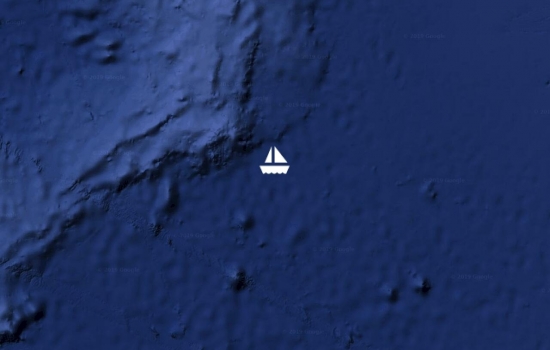
Avg: 7.1knts
24hr: 169.8nm
OK! It's day six of our passage from Cape Town to St. Helena and we have survived the icky bit, the first days when one wants nothing more than to sleep and can't do it even when time is available. Ew! Now we're in the breezing along stage! Mersoleil left Cape Town in the late afternoon last Saturday, moving right into a cold damp night with near shore fog, prompting us to learn how to use our new VHF radio to operate the fog horn. For the first few days we had nice brisk winds, 15-25kts mostly, and lots of gybing practice, so while distance made good is nothing to brag about, we covered a fair amount of water and got pretty accomplished at bringing the boom across with full sail and no drama.
The wind will dust our stern for nearly this entire passage, and when the breeze dropped this morning to less than 9kts we set the pole and are now, one can hardly say running, poking along might be more to the point, wing and wing, with the main to port and the genoa to starboard. We always hope a w/w sail plan will stop the rolling in dead downwind conditions. Note to self - It does not. But it's amusing to look up at our lovely new sails spread out against the sky and there's little one can do to tweak the rigging once it's all set up, so we're settled in for a leisurely afternoon, or day, or few days, or possibly a week.
St. Helena is less than 1000nm away, we've gobbled up almost half the distance and are having a grand time.
Nights grow warmer as each day passes. So far, I've worn the same clothes every day, (there's a prize at the end of the passage for having the least laundry) but last night I never felt chilled and tonight I'll have to scale down by one layer. Here at 26 degrees S it's too warm in the sun for any of the long and fleecy garments we've been wearing so a new wardrobe plan is evolving.
We send our love and beg for news from your end. We've plenty of time to read!
Avg: 4.6knts
24hr: 110.2nm
On Saturday afternoon, the 2nd of February, we pried ourselves away from Cape Town, the lovely V&A Marina and five kind friends waving goodbye at the dock. Our visit to South AFrica was another highlight of Mersoleil's cruising career and we have much to share with you about South Africa when time allows. About the dear people we met and with whom we shared our time, about her version of the English language, about her cuisine, about the differences among "now." "now now," and "just now," the superior marine services we received and, too, about her struggle to recover from a long sad tradition of hateful relations among her own people, one that seems struggling to survive. It will be at least another week before we reach St. Helena, and we're already well on our way on one of the easiest passages we've enjoyed in years. The trade winds do not disappoint, as usual, though I do wonder how they can manage to be always directly at our back or on the nose. We're making huge gybes avery hundred miles or so swinging about 80 degrees to keep the wind on one quarter or the other. If .we did the obvious thing, sailed straight on with the wind directly behind, we'd be wallowing like a piggy in the mud and everything inside would fly about causing an awful mess.
It was not time to leave South Africa, and we depart sad to go, but it is time to begin making our way to the Mediterranean if we want to enjoy summertime there! Life is very very good and we are grateful.
Christmas in South Africa
Until this year we knew Kevin Butcher and Suzanne Hedley only as other yachties, fun, enjoyable folks who live on the water like we do, visiting the islands and the peoples who live at sea level around the world. But they have a secret life, as some cruisers do, we do not, on land at their South African home outside Cape Town and their riverside getaway, Tides River Lodge, some twenty miles up the Breede River from the south coast.
Robbie and I spent Christmas 2018 with Suzanne and Butch, their family and friends, some 22 in all, at the river, enjoying delightful South African holiday traditions and cuisine.
Six hours' drive from Cape Town we descended 2000 feet from the rich farmlands of the Cape Fold Mountain valleys to the arid coastal plateau and eventually nearly to sea level where the Breede River rises and falls with the tides while the sea lies a further 30km down river. There was some doubt as we bumped and skidded along 47km of dirt road between the N2 and the lodge whether our little RentaCheapie Toyota, barely a few inches off the ground, would be up to the task of returning us to higher ground at the end of our stay and we resolved to be among the earliest vehicles to depart in case assistance was needed in pushing our little buggy up some of the steeper inclines.
Walking, swimming, eating, drinking, reading, socializing with new friends, bird watching and afternoon-napping filled several happy days at the lodge where our group filled all bedrooms in the four cozy homes on the property. The rustic locale did not prevent us laying out an elaborate candlelight Christmas feast as you can see below and we'll not soon forget Christmas 2018.
No blogs available for this yacht.

